



 2023 production To Fire You Come at Last by author-playwright-director Sean Hogan, a
2023 production To Fire You Come at Last by author-playwright-director Sean Hogan, a  45-minute ode to the long-form '70s British TV productions that still creep out new generations of viewers. The (mostly) black-and-white mood piece follows three men led by the aged Squire Marlow (Carlisle) on an hours-long journey through the woods transporting his son's body to a churchyard. A fourth straggler (a scene-stealing Swanton) joins them on a journey that veers through a hazardous, superstition-laden road with the promise of higher compensation, a process that uncovers secrets and puts them in mortal danger. Reminiscent of the first set's A Field in England by way of A Ghost Story for Christmas, it's beautifully shot and scored with a thick mood that makes for an engaging extended vignette. The horror content is fairly low, but it's creepy for sure and has some effective twists in the final stretch.
45-minute ode to the long-form '70s British TV productions that still creep out new generations of viewers. The (mostly) black-and-white mood piece follows three men led by the aged Squire Marlow (Carlisle) on an hours-long journey through the woods transporting his son's body to a churchyard. A fourth straggler (a scene-stealing Swanton) joins them on a journey that veers through a hazardous, superstition-laden road with the promise of higher compensation, a process that uncovers secrets and puts them in mortal danger. Reminiscent of the first set's A Field in England by way of A Ghost Story for Christmas, it's beautifully shot and scored with a thick mood that makes for an engaging extended vignette. The horror content is fairly low, but it's creepy for sure and has some effective twists in the final stretch. plenty of separation in the music. The optional English subtitles are very welcome as some of the dialogue veers to the whispered or mumbly side at times. An audio commentary with Hogan and co-producers Paul Goodwin and Nicholas
plenty of separation in the music. The optional English subtitles are very welcome as some of the dialogue veers to the whispered or mumbly side at times. An audio commentary with Hogan and co-producers Paul Goodwin and Nicholas  Harwood running through the production process, the wrangling of the actors' and characters' accents, the folklore inspirations for various scenes, and the tricks to shooting in the dark in monochrome. In "On The Lych Way" (16m3s), "corpse road chronicler" Dr. Stuart Dunn gives an interesting tutorial in the pathways used to transport the dead in England, Scotland, France, and other areas before mass transportation with dedicated routes leading to unique customs and stories. A trailer is also included along with Hogan's short film We Always Find Ourselves in the Sea (22m25s) with optional commentary by the same trio. Shot in extremely desaturated color, it's an enigmatic seaside Christmas ghost story about the lonely, haunted Patrick (Billy Clarke) whose fraught relationship with his daughter, Nina (Jamie Birkett), turns his yuletide into a very unpleasant one. Also included are a 9m46s EPK for the
Harwood running through the production process, the wrangling of the actors' and characters' accents, the folklore inspirations for various scenes, and the tricks to shooting in the dark in monochrome. In "On The Lych Way" (16m3s), "corpse road chronicler" Dr. Stuart Dunn gives an interesting tutorial in the pathways used to transport the dead in England, Scotland, France, and other areas before mass transportation with dedicated routes leading to unique customs and stories. A trailer is also included along with Hogan's short film We Always Find Ourselves in the Sea (22m25s) with optional commentary by the same trio. Shot in extremely desaturated color, it's an enigmatic seaside Christmas ghost story about the lonely, haunted Patrick (Billy Clarke) whose fraught relationship with his daughter, Nina (Jamie Birkett), turns his yuletide into a very unpleasant one. Also included are a 9m46s EPK for the  short featuring interviews and making-of footage with Hogan and the two leads, plus Our Selves Unknown (3m9s), a 2014 short by Edwin
short featuring interviews and making-of footage with Hogan and the two leads, plus Our Selves Unknown (3m9s), a 2014 short by Edwin  Rostron turning elements of a book called Landscape in Distress into a jagged experimental project.
Rostron turning elements of a book called Landscape in Distress into a jagged experimental project.  film has haunted the shelves of countless video stores over the years, sneakily lurking in wait for unsuspecting viewers destined to be left speechless by its hallucinatory fusion
film has haunted the shelves of countless video stores over the years, sneakily lurking in wait for unsuspecting viewers destined to be left speechless by its hallucinatory fusion  of rebellious mod youths, spooky zombie mayhem, loud motorcycle chases, and... uh, supernatural frogs. Though it contains all the elements of a perfect drive-in film, Psychomania plays out as anything but a run of the mill zombie movie. The strange mingling of old pros like Sanders and Reid (a veteran of lowbrow junk food like Beast in the Cellar and highbrow junk food like The Killing of Sister George) with the game young cast makes for an odd clash of youth movement and classic horror, with some froggy cult worship thrown in to make the plot even odder. Shortly after the completion of Psychomania and before its actual release, he committed suicide in Barcelona, Spain on April 25, 1972, leaving behind a darkly witty, oft-quoted note. As film writer Michael J. Weldon noted, he did not return on a motorcycle. One real scene stealer in the cast is the beautiful Ann Michelle as bad girl Jane, best remembered for British horror cult films like House of Whipcord and Virgin Witch.
of rebellious mod youths, spooky zombie mayhem, loud motorcycle chases, and... uh, supernatural frogs. Though it contains all the elements of a perfect drive-in film, Psychomania plays out as anything but a run of the mill zombie movie. The strange mingling of old pros like Sanders and Reid (a veteran of lowbrow junk food like Beast in the Cellar and highbrow junk food like The Killing of Sister George) with the game young cast makes for an odd clash of youth movement and classic horror, with some froggy cult worship thrown in to make the plot even odder. Shortly after the completion of Psychomania and before its actual release, he committed suicide in Barcelona, Spain on April 25, 1972, leaving behind a darkly witty, oft-quoted note. As film writer Michael J. Weldon noted, he did not return on a motorcycle. One real scene stealer in the cast is the beautiful Ann Michelle as bad girl Jane, best remembered for British horror cult films like House of Whipcord and Virgin Witch. 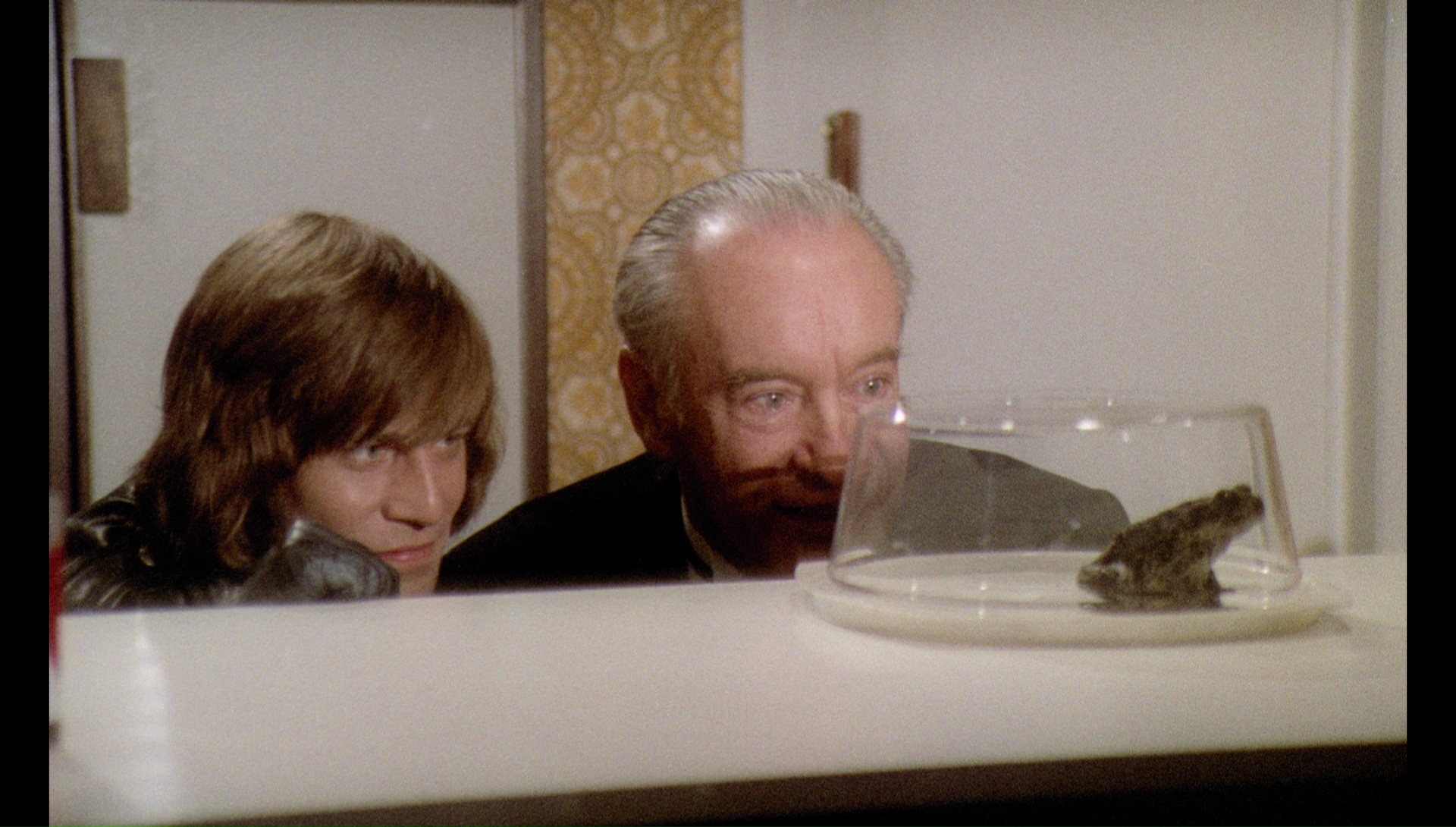 with other credits including A Man for All Seasons and would soon do the last three Ray
with other credits including A Man for All Seasons and would soon do the last three Ray 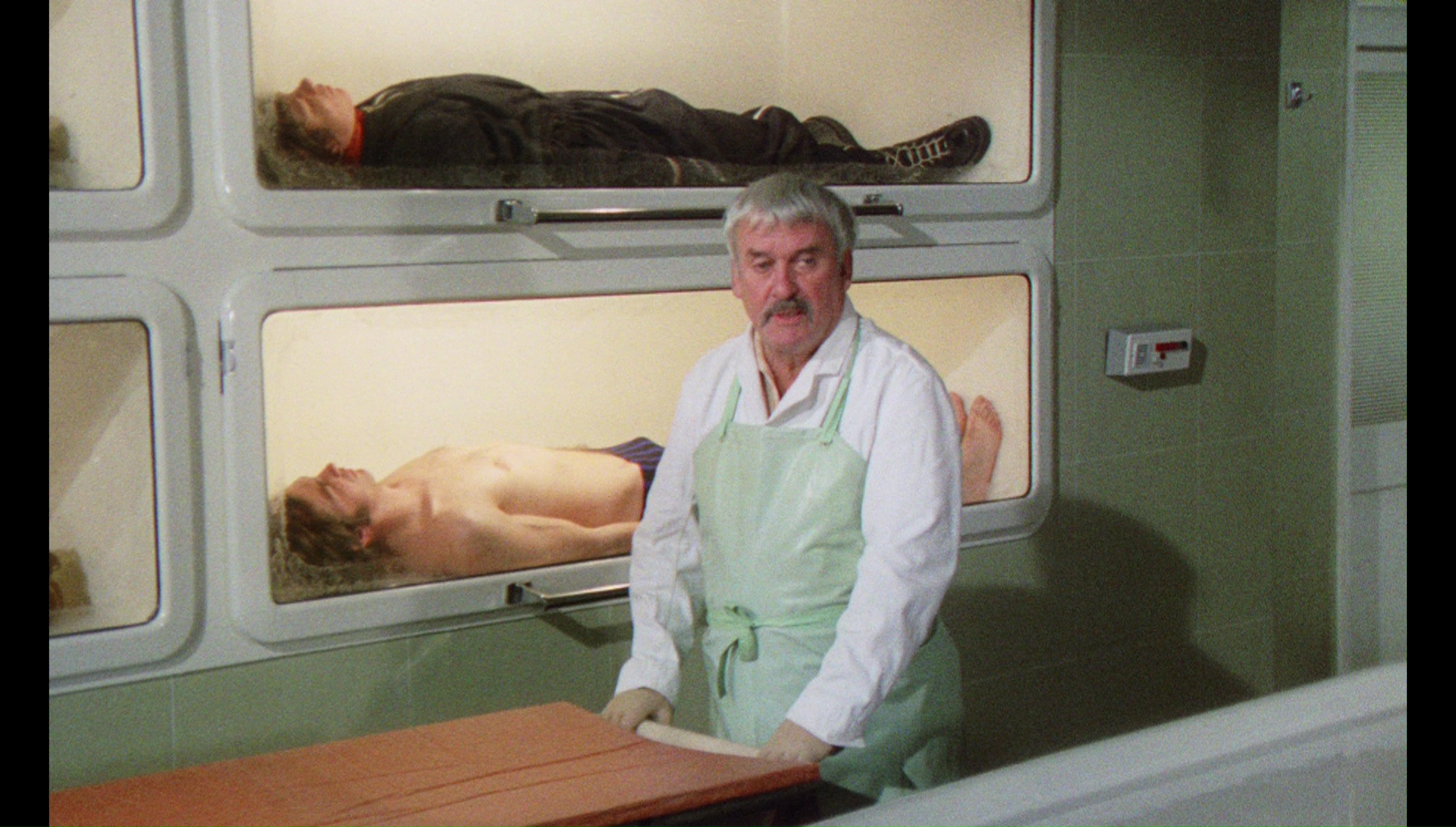 Harryhausen features, The Golden Voyage of Sinbad, Sinbad and the Eye of the Tiger, and Clash of the Titans. The strange, creepy quasi-pop score by John Cameron (one of the most prolific library music composers of the '70s) puts just the right polish on the action, making this a unique artifact for any horror collection. You could also pop it on as a double feature with Werewolves on Wheels and enjoy.
Harryhausen features, The Golden Voyage of Sinbad, Sinbad and the Eye of the Tiger, and Clash of the Titans. The strange, creepy quasi-pop score by John Cameron (one of the most prolific library music composers of the '70s) puts just the right polish on the action, making this a unique artifact for any horror collection. You could also pop it on as a double feature with Werewolves on Wheels and enjoy. 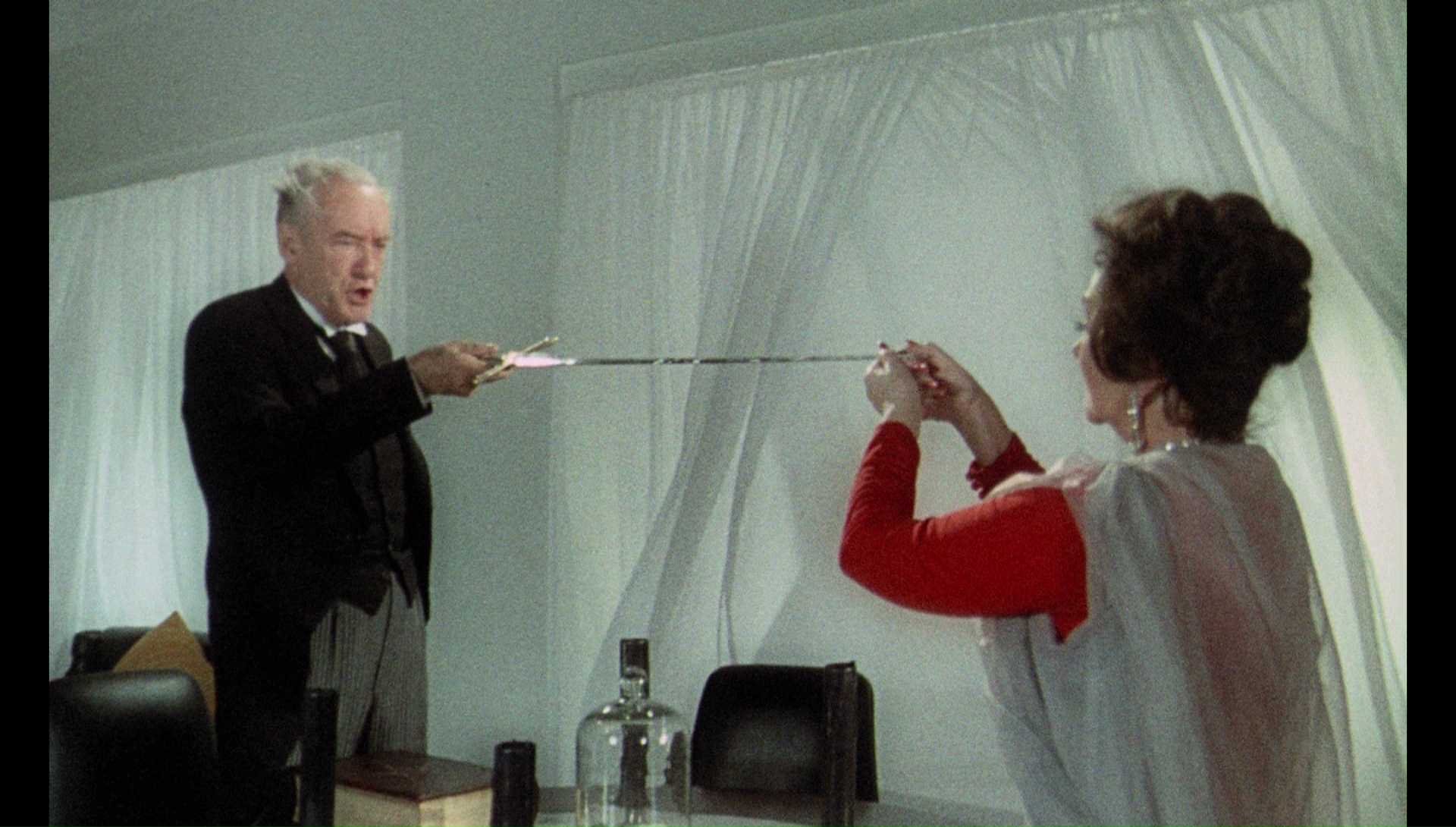 what everyone regarded as a substandard script. Also present are Larkin (who discusses Reid's "instructive" tendencies and points out she had no idea how to ride a bike,
what everyone regarded as a substandard script. Also present are Larkin (who discusses Reid's "instructive" tendencies and points out she had no idea how to ride a bike, 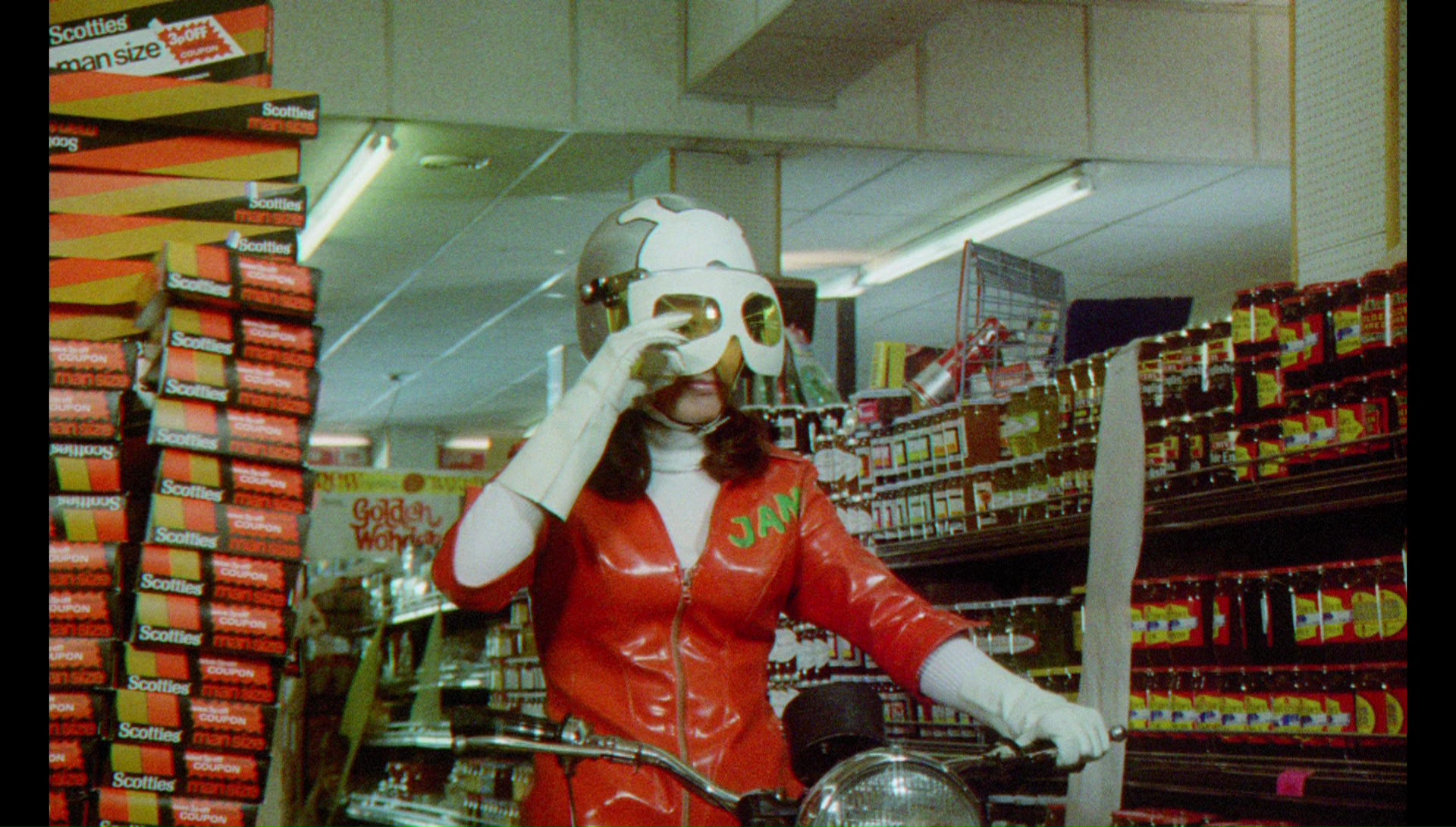 simply straddling an idle one at all times on screen), Denis Gilmore (who plays Hatchet and mentions some of his other genre appearances like Tomb of Ligeia and Blood on Satan's Claw), Roy Holder (who plays Bertram and had a few Zeffirelli credits under his belt already!), and stunt man Rocky Taylor (who also plays Hinky on screen), who worked on every 007 film -- including the infamous rival ones in 1983. "The Sound of Psychomania" (9m8s) is an interesting, shorter featurette with composer John Cameron, who talks about his trial by fire doing film scoring under an insanely short schedule and also covers some of his other major scores (including Kes); his music is such a major part of the film that it's gratifying to see him getting a spotlight here. "Riding Free" (6m30s) features singer Harvey Andrews discussing the creation of the memorable ballad of the same name in the film, which is mimed by a different actor on screen, while former Fangoria editor Chris Alexander offers a 5m32s introduction from the vantage point of nostalgic VHS junkies who have cherished this film for years. Last up is a surprisingly good transfer of the obscure theatrical trailer under its original title.
simply straddling an idle one at all times on screen), Denis Gilmore (who plays Hatchet and mentions some of his other genre appearances like Tomb of Ligeia and Blood on Satan's Claw), Roy Holder (who plays Bertram and had a few Zeffirelli credits under his belt already!), and stunt man Rocky Taylor (who also plays Hinky on screen), who worked on every 007 film -- including the infamous rival ones in 1983. "The Sound of Psychomania" (9m8s) is an interesting, shorter featurette with composer John Cameron, who talks about his trial by fire doing film scoring under an insanely short schedule and also covers some of his other major scores (including Kes); his music is such a major part of the film that it's gratifying to see him getting a spotlight here. "Riding Free" (6m30s) features singer Harvey Andrews discussing the creation of the memorable ballad of the same name in the film, which is mimed by a different actor on screen, while former Fangoria editor Chris Alexander offers a 5m32s introduction from the vantage point of nostalgic VHS junkies who have cherished this film for years. Last up is a surprisingly good transfer of the obscure theatrical trailer under its original title.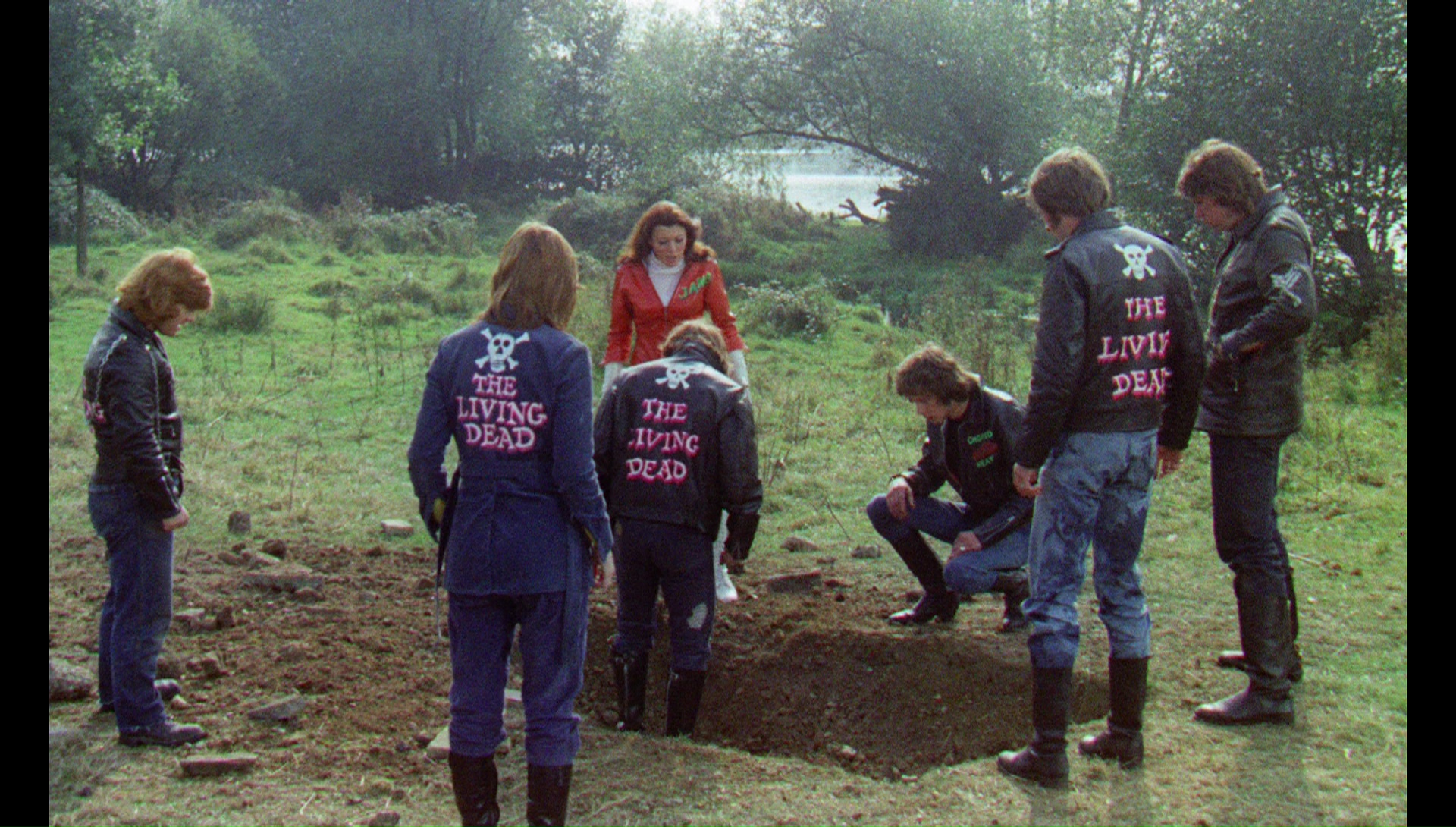 perfect fidelity, and the detail level is often astonishing with countless details never even remotely visible
perfect fidelity, and the detail level is often astonishing with countless details never even remotely visible  before. The whole film has a classy veneer now that easily makes it a competitor to the best-looking Amicus titles of the period, and there's nary a speck or scratch to be found. The LPCM English mono audio (with optional English subtitles) is also a remarkable improvement with a strong dynamic range and sturdy support for the score, which now has real presence and induces chills as soon as it kicks in during the main titles. The film can also be played with a "Wilson Bros. Trivia Track" offering pop-up tidbits about the film throughout the running time, covering everything from the models of motorcycles to the stories of each significant actor. The "literally dancing around it" bit is especially priceless.
before. The whole film has a classy veneer now that easily makes it a competitor to the best-looking Amicus titles of the period, and there's nary a speck or scratch to be found. The LPCM English mono audio (with optional English subtitles) is also a remarkable improvement with a strong dynamic range and sturdy support for the score, which now has real presence and induces chills as soon as it kicks in during the main titles. The film can also be played with a "Wilson Bros. Trivia Track" offering pop-up tidbits about the film throughout the running time, covering everything from the models of motorcycles to the stories of each significant actor. The "literally dancing around it" bit is especially priceless. enthusiastic appraisal of the film by Vic Pratt, a look at Sanders' history with the film by William Fowler, a study of postwar teen horror
enthusiastic appraisal of the film by Vic Pratt, a look at Sanders' history with the film by William Fowler, a study of postwar teen horror  films and this one in particular by Andrew Roberts, and brief notes about the two short films.
films and this one in particular by Andrew Roberts, and brief notes about the two short films.  draw thanks to the inclusion of two rare features, starting with the Florida
draw thanks to the inclusion of two rare features, starting with the Florida  backwoods mystical trip The Enchanted. Feeling a lot like a Deep South spin on Malpertuis, the film follows the return of Royce (Miller) to his family home, which is now abandoned and decaying. Still resistrant to selling the property, he reconnects with family friend Booker (Harris) and becomes entranced with one of the closest neighbors, mural painter Twyla (Blanton), but Booker warns him to steer clear of her and her laborer family. For the most part it's a sweaty study in atmosphere, but the supernatural elements gradually take over as the true nature of what's going on becomes clear. (No points for guessing it has something to do with the barrage of owl imagery scattered throughout.) Shot mostly in 1981 but barely released three years later (with at least on TV airing and a self-distributed DVD not doing much to bolster its reputation), The Enchanted is a fascinating balancing act between regional detail and dark magic realism centered
backwoods mystical trip The Enchanted. Feeling a lot like a Deep South spin on Malpertuis, the film follows the return of Royce (Miller) to his family home, which is now abandoned and decaying. Still resistrant to selling the property, he reconnects with family friend Booker (Harris) and becomes entranced with one of the closest neighbors, mural painter Twyla (Blanton), but Booker warns him to steer clear of her and her laborer family. For the most part it's a sweaty study in atmosphere, but the supernatural elements gradually take over as the true nature of what's going on becomes clear. (No points for guessing it has something to do with the barrage of owl imagery scattered throughout.) Shot mostly in 1981 but barely released three years later (with at least on TV airing and a self-distributed DVD not doing much to bolster its reputation), The Enchanted is a fascinating balancing act between regional detail and dark magic realism centered  around the idea of a "hole in the wall" in the region that joins two different worlds. The
around the idea of a "hole in the wall" in the region that joins two different worlds. The  PG rating card at the beginning should tip you right off that this won't be terribly horrifying, but if you're in the right frame of mind it's an eerie and meditative trip.
PG rating card at the beginning should tip you right off that this won't be terribly horrifying, but if you're in the right frame of mind it's an eerie and meditative trip.  Sheree Renée Thomas is very jovial as they clearly
Sheree Renée Thomas is very jovial as they clearly  enjoy rifling through all the material in the film including its treatment of class, race, Southern culture, folklore, and lots more. In "A Magical Place" (11m41s), Sawyer talks about his musical background and love of guitar playing and Stravinsky as a child that led to his career and his gig writing the music for this film. Then "Hole in the Wall" (4m31s) is a collection of "character notes" by screenwriter Charné Porter laying out notes about the "now" existence of the main characters and the driving forces behind everyone in the film. Also included are a very short trailer (which looks more like a TV spot) and the only other film work by Lord, Swimmer (24m33s), a 1973 short about artist Don Seiler (who provided the Twyla murals in The Enchanted) and his work on a gigantic project in tribute to Olympic swimmer Mark Spitz. That's the concept anyway, but the execution here is very similar to the main feature with a focus on natural elements and dreamy cinematography and music creating a nice little aesthetic spell.
enjoy rifling through all the material in the film including its treatment of class, race, Southern culture, folklore, and lots more. In "A Magical Place" (11m41s), Sawyer talks about his musical background and love of guitar playing and Stravinsky as a child that led to his career and his gig writing the music for this film. Then "Hole in the Wall" (4m31s) is a collection of "character notes" by screenwriter Charné Porter laying out notes about the "now" existence of the main characters and the driving forces behind everyone in the film. Also included are a very short trailer (which looks more like a TV spot) and the only other film work by Lord, Swimmer (24m33s), a 1973 short about artist Don Seiler (who provided the Twyla murals in The Enchanted) and his work on a gigantic project in tribute to Olympic swimmer Mark Spitz. That's the concept anyway, but the execution here is very similar to the main feature with a focus on natural elements and dreamy cinematography and music creating a nice little aesthetic spell.  including some minor nudity) and run under the title The Legend of Hillbilly John with a G rating. This one
including some minor nudity) and run under the title The Legend of Hillbilly John with a G rating. This one  caused a bit of a stir a while ago when Kino Lorber announced a Blu-ray (complete with artwork and specs) only to pull it over rights issues. Thankfully the film has finally seen the light of day here after a long time in limbo (its last outing was a laserdisc from Image Entertainment licensed from Jack H. Harris), and it's great to have this crazy supernatural Appalachian musical morality fable back again. An episodic adaptation of fantasy writer Manly Wade Wellman's John the Balladeer (a.k.a. Silver John or Hillbilly John) tales, this film from director John Newland (Don't Be Afraid of the Dark) takes place in a mountain community where, in the best folk song tradition, the devil and his minions occasionally pop up to take advantage of humans by facing off against them in music challenges. One of them is Grandpappy John (The Dukes of Hazzard's Pyle), which is enough to send our younger hero, his son John (real-life singer Capers), to pick up his six-string guitar for a very surreal odyssey and and off with his girlfriend Lily (Henesy) through the mining regions and forests around him where he encounters a stop-motion demon bird, a wild slate of guest actors including R.G. Armstrong, a dip in the lake with Severn Darden, and a
caused a bit of a stir a while ago when Kino Lorber announced a Blu-ray (complete with artwork and specs) only to pull it over rights issues. Thankfully the film has finally seen the light of day here after a long time in limbo (its last outing was a laserdisc from Image Entertainment licensed from Jack H. Harris), and it's great to have this crazy supernatural Appalachian musical morality fable back again. An episodic adaptation of fantasy writer Manly Wade Wellman's John the Balladeer (a.k.a. Silver John or Hillbilly John) tales, this film from director John Newland (Don't Be Afraid of the Dark) takes place in a mountain community where, in the best folk song tradition, the devil and his minions occasionally pop up to take advantage of humans by facing off against them in music challenges. One of them is Grandpappy John (The Dukes of Hazzard's Pyle), which is enough to send our younger hero, his son John (real-life singer Capers), to pick up his six-string guitar for a very surreal odyssey and and off with his girlfriend Lily (Henesy) through the mining regions and forests around him where he encounters a stop-motion demon bird, a wild slate of guest actors including R.G. Armstrong, a dip in the lake with Severn Darden, and a  witchy Susan
witchy Susan  Strasberg.
Strasberg.  included as an extra with Darden doing a spoken introduction standing among some trees, and then producer Barney Rosenweig appears in the featurette "Crumble Will the Feet of
included as an extra with Darden doing a spoken introduction standing among some trees, and then producer Barney Rosenweig appears in the featurette "Crumble Will the Feet of  Clay" (35m6s) to talk about his award-winning career (including Cagney and Lacey) and the "noble effort" of this film that he doesn't seem to hold in tremendously high esteem. In "Silver Strings" (20m44s), Capers talks about his attraction to the source material and how he interprets the stories, as well as his contributions to the film in both acting and musical capacities including the filming of the strip mine bird chase scene. In "Manly of the Mountains" (16m36s), author David Drake charts out all the essentials of friend Manly Wade Wellman and his work, as well as their connections to North Carolina. Finally in "Occult Appalachia" (22m31s), occult historian Mitch Horowitz parses out the sometimes challenging elements of Wellman's stories which integrate numerous genres and sometimes obscure cultural traditions and references. A theatrical trailer ("Somewhere between Billy Jack and the Wizard of Oz!") is also included.
Clay" (35m6s) to talk about his award-winning career (including Cagney and Lacey) and the "noble effort" of this film that he doesn't seem to hold in tremendously high esteem. In "Silver Strings" (20m44s), Capers talks about his attraction to the source material and how he interprets the stories, as well as his contributions to the film in both acting and musical capacities including the filming of the strip mine bird chase scene. In "Manly of the Mountains" (16m36s), author David Drake charts out all the essentials of friend Manly Wade Wellman and his work, as well as their connections to North Carolina. Finally in "Occult Appalachia" (22m31s), occult historian Mitch Horowitz parses out the sometimes challenging elements of Wellman's stories which integrate numerous genres and sometimes obscure cultural traditions and references. A theatrical trailer ("Somewhere between Billy Jack and the Wizard of Oz!") is also included. 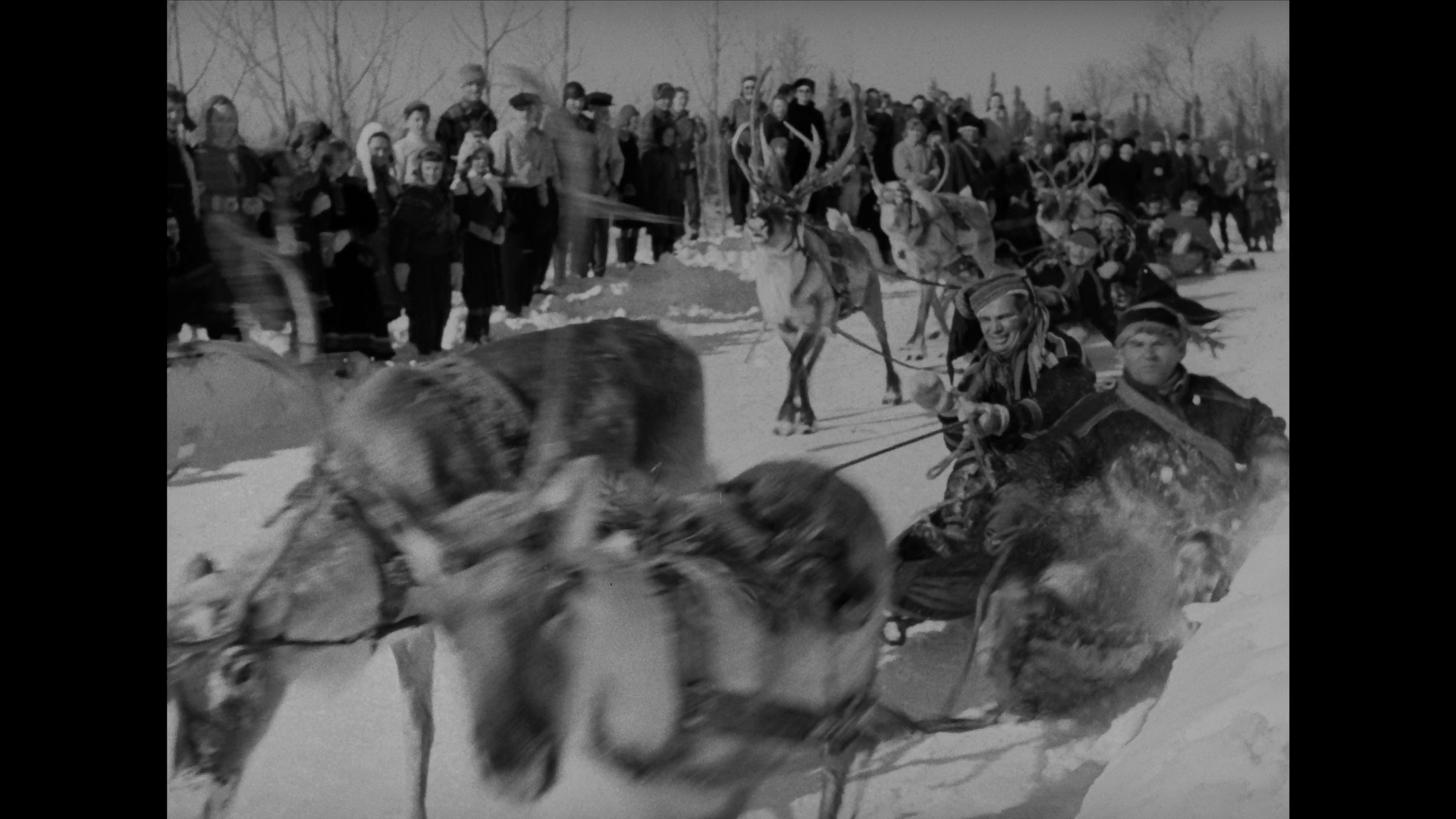 classified as a vampire film but more off-center than that, The White Reindeer is an eerie and
classified as a vampire film but more off-center than that, The White Reindeer is an eerie and  spectacularly filmed addition to the catalog of horror films (in the loosest, artiest sense) about sexual anxiety represented through animal transformation (think Cat People or The Company of Wolves). The world doesn't have too many shapeshifting supernatural epics set against Lapland scenery, but here's one, and it's absolutely worth seeing.
spectacularly filmed addition to the catalog of horror films (in the loosest, artiest sense) about sexual anxiety represented through animal transformation (think Cat People or The Company of Wolves). The world doesn't have too many shapeshifting supernatural epics set against Lapland scenery, but here's one, and it's absolutely worth seeing. 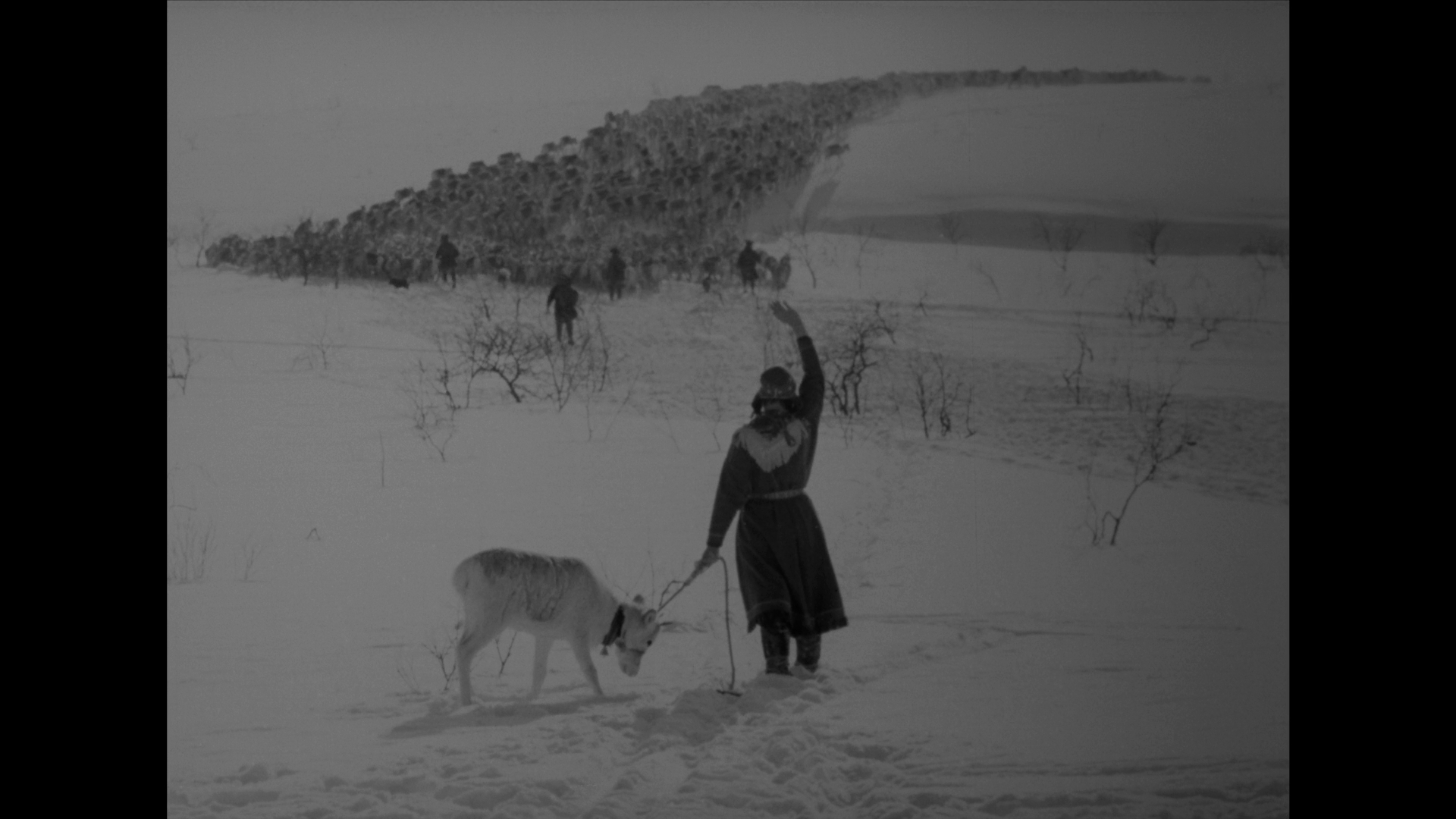
 it only runs a bit over an hour, you could easily write a few term papers about this film's intoxicating portrayal of gender warfare, paganism (represented by Pirita's amazing reindeer bone construction that plays a pivotal role in her transformation), and social pressure. It's also an incredible visual document of the culture, with an early reindeer racing sequence letting you know right off the bat this will be a long, long way from the usual monster movies that had dominated the previous two decades. Despite the fact that the film nabbed prizes at the Golden Globes and Cannes, it's strangely underseen in English-speaking territories and really only known in American to die-hard horror movie fans who had to dig hard to find a copy and even harder to find one useful for English-speaking viewers. However, even without subtitles it's a magnetic experience with Kuosmanen's performance in particular making this an indelible and often unclassifiable experience that's hard to shake.
it only runs a bit over an hour, you could easily write a few term papers about this film's intoxicating portrayal of gender warfare, paganism (represented by Pirita's amazing reindeer bone construction that plays a pivotal role in her transformation), and social pressure. It's also an incredible visual document of the culture, with an early reindeer racing sequence letting you know right off the bat this will be a long, long way from the usual monster movies that had dominated the previous two decades. Despite the fact that the film nabbed prizes at the Golden Globes and Cannes, it's strangely underseen in English-speaking territories and really only known in American to die-hard horror movie fans who had to dig hard to find a copy and even harder to find one useful for English-speaking viewers. However, even without subtitles it's a magnetic experience with Kuosmanen's performance in particular making this an indelible and often unclassifiable experience that's hard to shake. 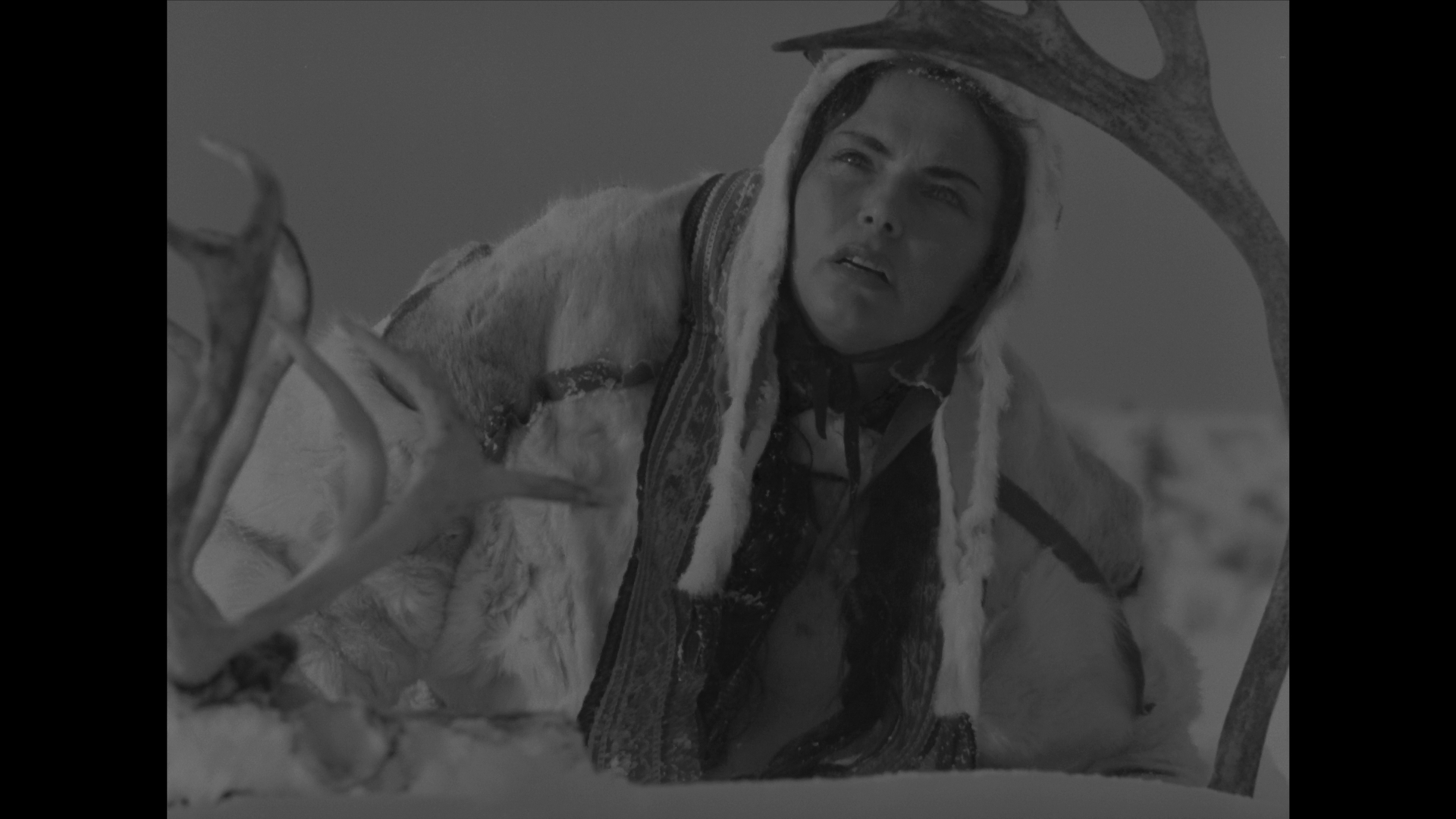 featuring English, French, or Spanish subtitles for the Finnish dialogue. A better option came with the
featuring English, French, or Spanish subtitles for the Finnish dialogue. A better option came with the 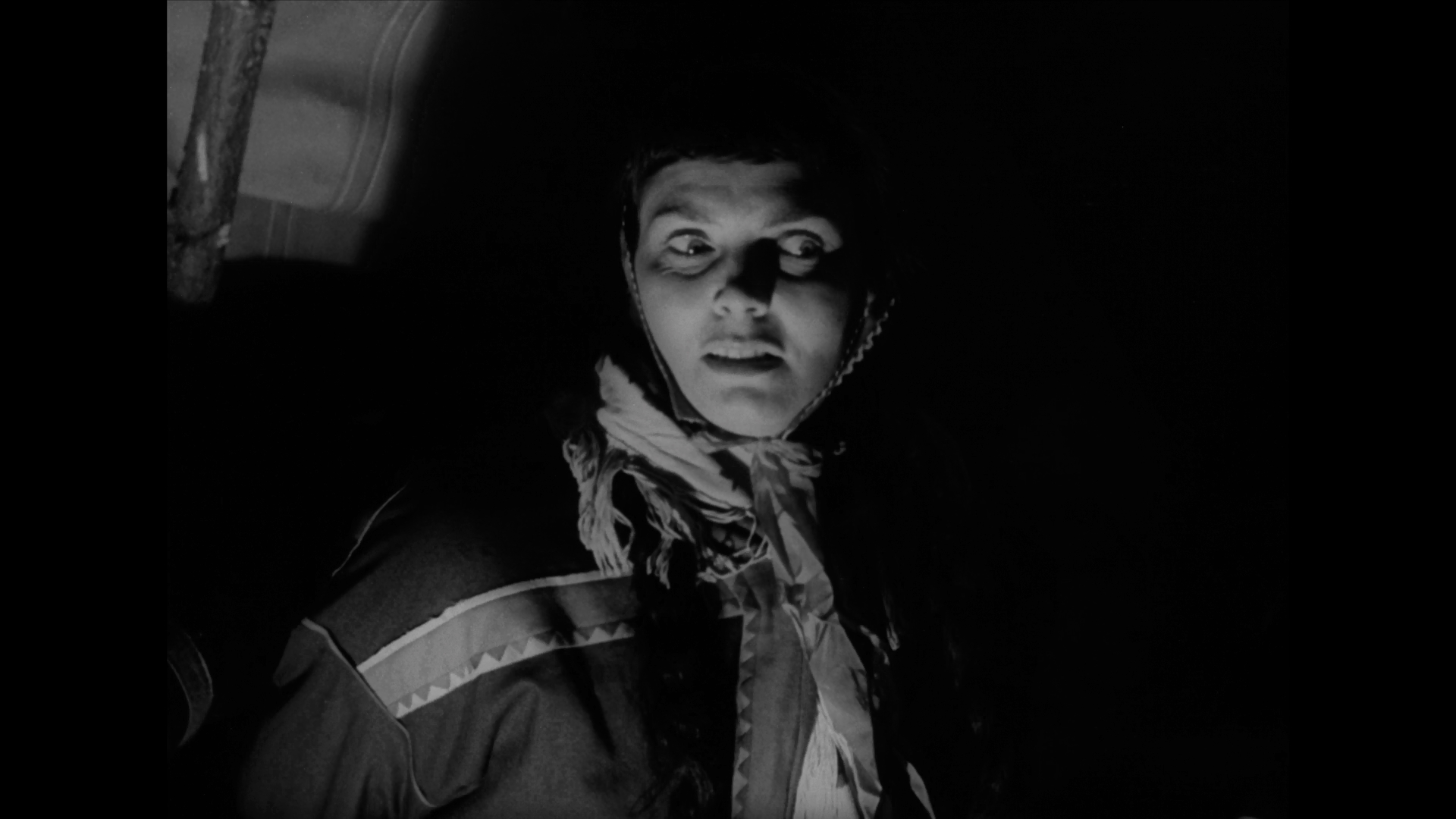 beautiful 2017 Finnish Blu-ray, which features optional English or Swedish subtitles for the Finnish dialogue (in LPCM 2.0 mono). The restored transfer looks great with only a few very mild blemishes here and there. Extras include a 1952 presentation at the Finnish Film Awards (1m9s), a fascinating silent sample of color test footage for the film (1m10s), and With the Reindeer (7m49s), a 1949 Blomberg short (again in beautiful quality) showing the vital role of the titular animals in Lapland daily life. The extras aren't subtitled, but it doesn't really matter. Eureka issued it on Blu-ray in the U.K. soon after featuring the same restoration, a commentary by Kat Ellinger, a video essay by Amy Simmons called "Religion, Pleasure, and Punishment: The Portrayal of Witches in Nordic Cinema," the "With the Reindeer" short, color test footage, and Jussi Awards footage, and an insert booklet with essays by Alexandra Heller-Nicholas and Philip Kemp. The Severin Blu-ray comes from the same restoration as well and, instead of the commentary, has an episode of The Projection Booth podcast with Mike White, Ellinger, and El Goro talking about the film's cinematic connections, its odd life over the decades, the director's sparse output, and their own personal responses to the story. Also included are three short films including the usual With the Reindeer, the reindeer-themed animated 1982 short The Witch Drum (10m14s), and the experimental The Nightside of the Sky (4m35s) from 2023 with Rhayne Vermette reassembling imagery from The White
beautiful 2017 Finnish Blu-ray, which features optional English or Swedish subtitles for the Finnish dialogue (in LPCM 2.0 mono). The restored transfer looks great with only a few very mild blemishes here and there. Extras include a 1952 presentation at the Finnish Film Awards (1m9s), a fascinating silent sample of color test footage for the film (1m10s), and With the Reindeer (7m49s), a 1949 Blomberg short (again in beautiful quality) showing the vital role of the titular animals in Lapland daily life. The extras aren't subtitled, but it doesn't really matter. Eureka issued it on Blu-ray in the U.K. soon after featuring the same restoration, a commentary by Kat Ellinger, a video essay by Amy Simmons called "Religion, Pleasure, and Punishment: The Portrayal of Witches in Nordic Cinema," the "With the Reindeer" short, color test footage, and Jussi Awards footage, and an insert booklet with essays by Alexandra Heller-Nicholas and Philip Kemp. The Severin Blu-ray comes from the same restoration as well and, instead of the commentary, has an episode of The Projection Booth podcast with Mike White, Ellinger, and El Goro talking about the film's cinematic connections, its odd life over the decades, the director's sparse output, and their own personal responses to the story. Also included are three short films including the usual With the Reindeer, the reindeer-themed animated 1982 short The Witch Drum (10m14s), and the experimental The Nightside of the Sky (4m35s) from 2023 with Rhayne Vermette reassembling imagery from The White  Reindeer into a
Reindeer into a  collage.
collage. featurette,
featurette,  "Retake" (24m22s). This isn't an easy language to learn, and the opportunity to see the few remaining speakers educating the actors is a highlight here along with interviews with directors Gwaai Edenshaw and Helen Haig-Brown exploring how they project evolved. The two also join up for an audio commentary going into more detail about the history of the language, its endangerment after a 1990 smallpox epidemic, and the development of the storyline using real local lore that would make it appealing for Haida audiences in particular. Also included are two short films: 1964's Haida Carver (12m15s) by Richard Gilbert showing a local stone artist at work (and seen here in a gorgeous restoration), and Nalujuk Night (13m11s), a very spooky 2021 short by Jennie Williams depicting an annual January tradition by Labrador Inuit who traverse the ice at night in very scary costumes. The digitally-shot film looks pristine throughout with no issues, and the DTS-HD 5.1 or 2.0 stereo Haida audio is very well mixed and active; the English subtitles are burned onto the master.
"Retake" (24m22s). This isn't an easy language to learn, and the opportunity to see the few remaining speakers educating the actors is a highlight here along with interviews with directors Gwaai Edenshaw and Helen Haig-Brown exploring how they project evolved. The two also join up for an audio commentary going into more detail about the history of the language, its endangerment after a 1990 smallpox epidemic, and the development of the storyline using real local lore that would make it appealing for Haida audiences in particular. Also included are two short films: 1964's Haida Carver (12m15s) by Richard Gilbert showing a local stone artist at work (and seen here in a gorgeous restoration), and Nalujuk Night (13m11s), a very spooky 2021 short by Jennie Williams depicting an annual January tradition by Labrador Inuit who traverse the ice at night in very scary costumes. The digitally-shot film looks pristine throughout with no issues, and the DTS-HD 5.1 or 2.0 stereo Haida audio is very well mixed and active; the English subtitles are burned onto the master. violent solar activity including
violent solar activity including  what appears to be a skull-like eclipse causes strange eruptions and nightmarish visions in targeted locations on Earth, a nameless female astronomer (The Draughtsman's Contract's Crowley) takes her findings to a tormented flutist, Paul (Firth), whose own nightmares appear to be related to his father, who died before his son's birth while seeking an enigmatic, possibly malefic Eastern entity known as the Master Musician (Oh-Tee). Together in Turkey they experience increasingly bizarre encounters involving djinns, dervishes, and the birth of a giant, slimy insect-like beast by our heroine.
what appears to be a skull-like eclipse causes strange eruptions and nightmarish visions in targeted locations on Earth, a nameless female astronomer (The Draughtsman's Contract's Crowley) takes her findings to a tormented flutist, Paul (Firth), whose own nightmares appear to be related to his father, who died before his son's birth while seeking an enigmatic, possibly malefic Eastern entity known as the Master Musician (Oh-Tee). Together in Turkey they experience increasingly bizarre encounters involving djinns, dervishes, and the birth of a giant, slimy insect-like beast by our heroine.  increased commercial exposure of artists like Jodorowsky and Arrabal made this much easier to digest now, especially with its first DVD appearance from Mondo Macabro.
Among the
increased commercial exposure of artists like Jodorowsky and Arrabal made this much easier to digest now, especially with its first DVD appearance from Mondo Macabro.
Among the  biggest surprises is the participation of Firth, an actor riding high at the time after Broadway successes like Amadeus and Equus (and later seen on the excellent TV series Spooks, better known to Yanks as MI-5). Fortunately he contributes a fascinating video interview (12m24s) to explain a bit about his career choices at the time (he turned down a lot of Hollywood projects, a decision about which he now feels conflicted) and his interest in the source material and director Dehlavi, who largely improvised the film around a framework of concepts to which he'd been exposed since childhood. These influences are explained further in an interview with the director, who admits in retrospect he might have been better following his true love of painting and expounds upon some of the magical ideas he wanted to explore wit4h this film. The challenges of shooting in Turkey (particularly the covert filming of some of the more unclothed sequences) also provides several anecdotal highlights. Last up is actor Shaban (who plays "The Silent One," a mysterious dervish) who talks more about his career
biggest surprises is the participation of Firth, an actor riding high at the time after Broadway successes like Amadeus and Equus (and later seen on the excellent TV series Spooks, better known to Yanks as MI-5). Fortunately he contributes a fascinating video interview (12m24s) to explain a bit about his career choices at the time (he turned down a lot of Hollywood projects, a decision about which he now feels conflicted) and his interest in the source material and director Dehlavi, who largely improvised the film around a framework of concepts to which he'd been exposed since childhood. These influences are explained further in an interview with the director, who admits in retrospect he might have been better following his true love of painting and expounds upon some of the magical ideas he wanted to explore wit4h this film. The challenges of shooting in Turkey (particularly the covert filming of some of the more unclothed sequences) also provides several anecdotal highlights. Last up is actor Shaban (who plays "The Silent One," a mysterious dervish) who talks more about his career 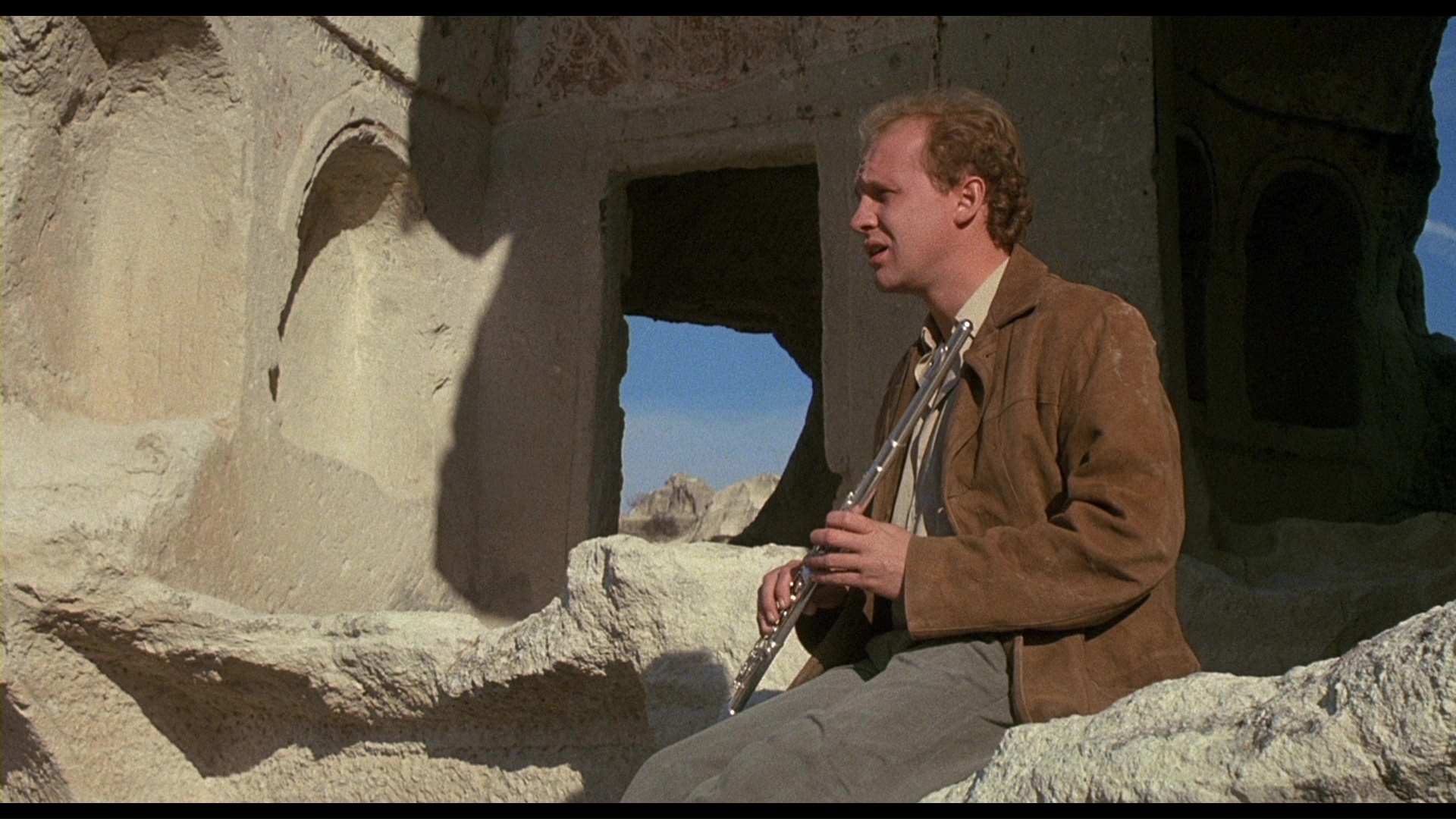 and the basic outline of the plot as it was originally presented. Pete Tombs contributes another outstanding, illuminating set of notes about the film (you really might want to read them before viewing the feature) and a dupey '80s Vidmark trailer used to promote the tape release. As for the transfer of the film
and the basic outline of the plot as it was originally presented. Pete Tombs contributes another outstanding, illuminating set of notes about the film (you really might want to read them before viewing the feature) and a dupey '80s Vidmark trailer used to promote the tape release. As for the transfer of the film 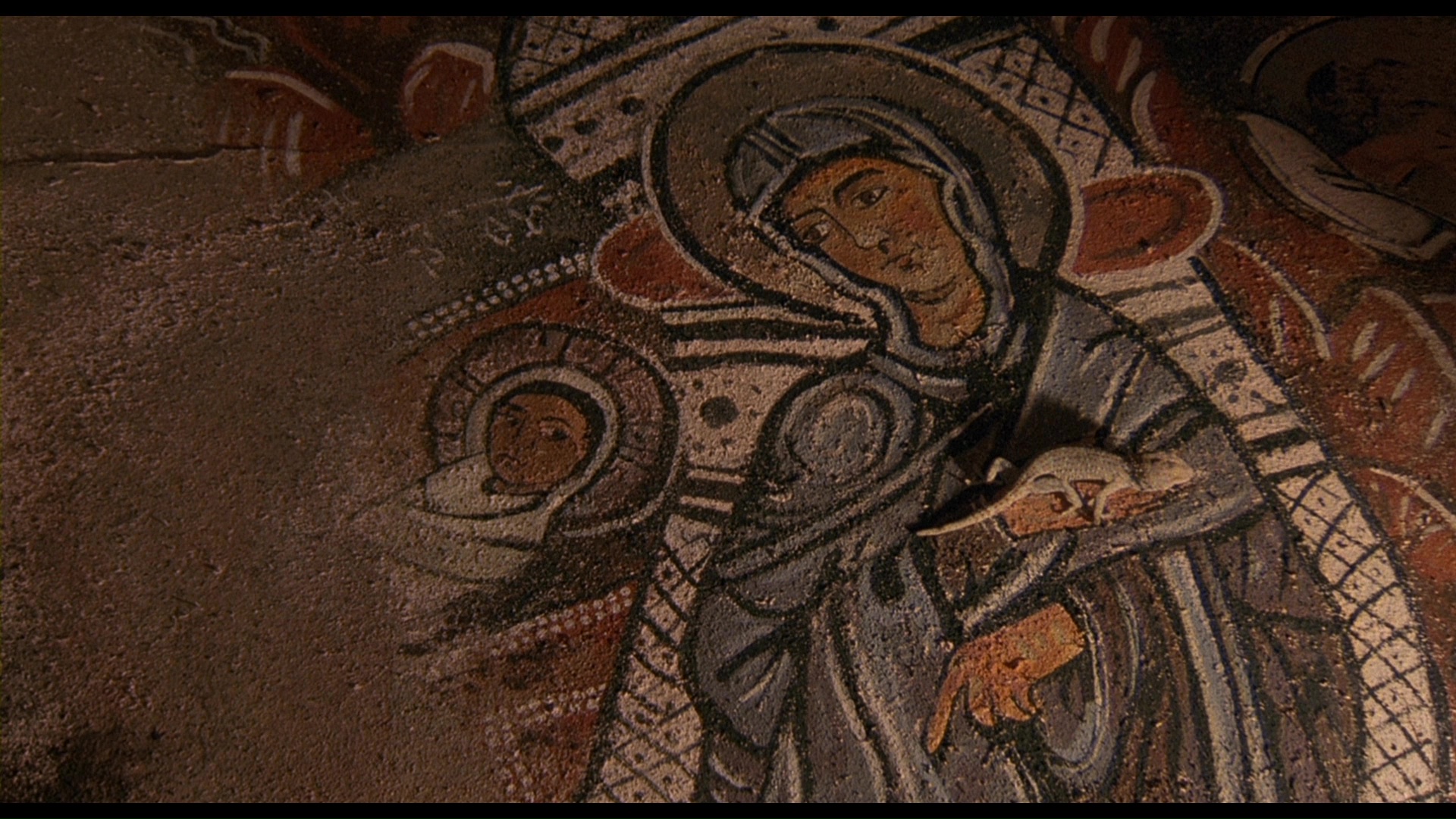 itself, it's a sensational upgrade from the scarce prior releases and finally does justice to the rich, often startling visuals, ranging from arid mountains and richly-textured caves to glistening ice formations.
itself, it's a sensational upgrade from the scarce prior releases and finally does justice to the rich, often startling visuals, ranging from arid mountains and richly-textured caves to glistening ice formations. 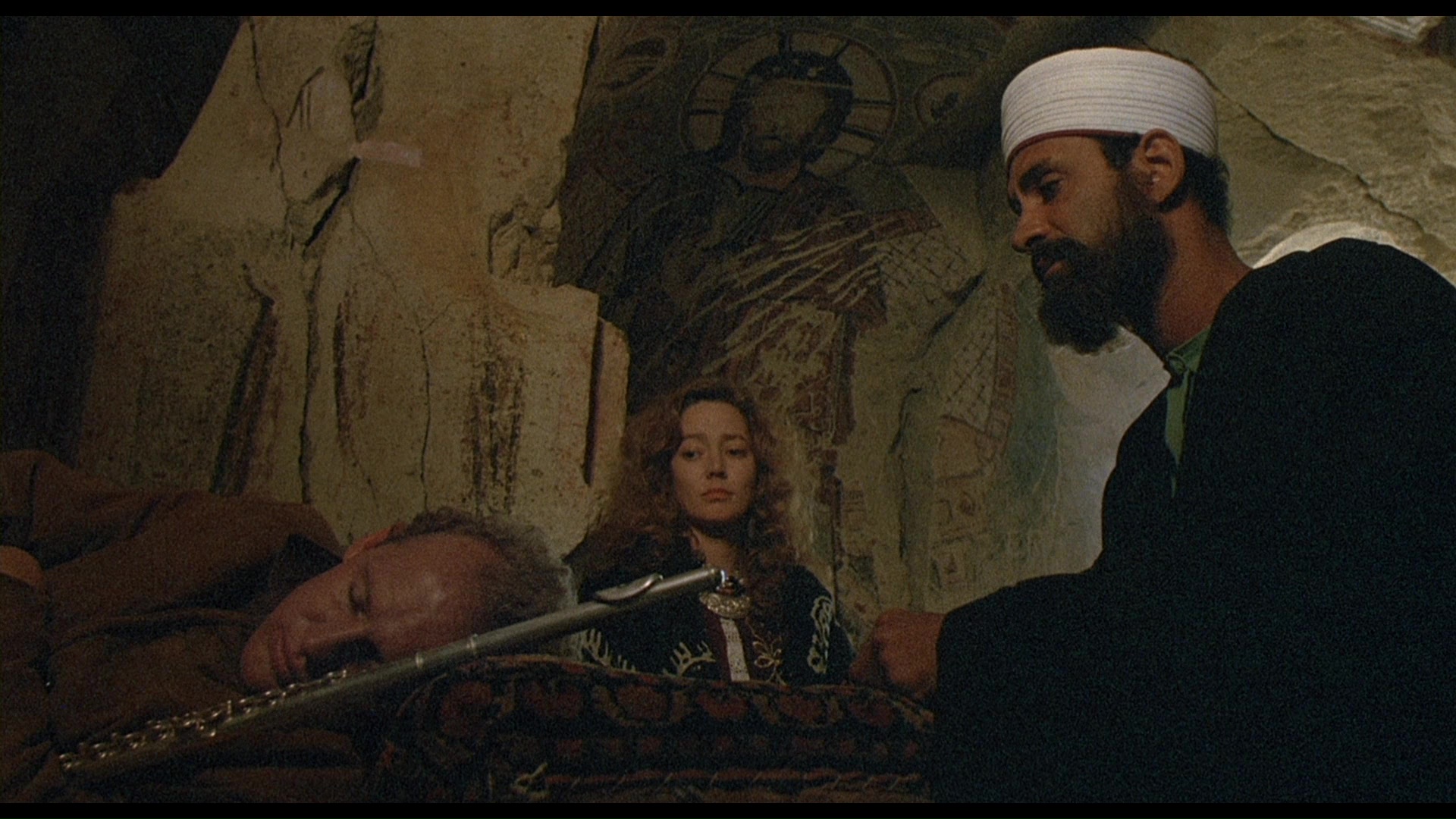 Werner Herzog. A new, different Dehlavi interview, "Playing with Fire" (18m8s), lays out the groundwork for how this film emerged
Werner Herzog. A new, different Dehlavi interview, "Playing with Fire" (18m8s), lays out the groundwork for how this film emerged 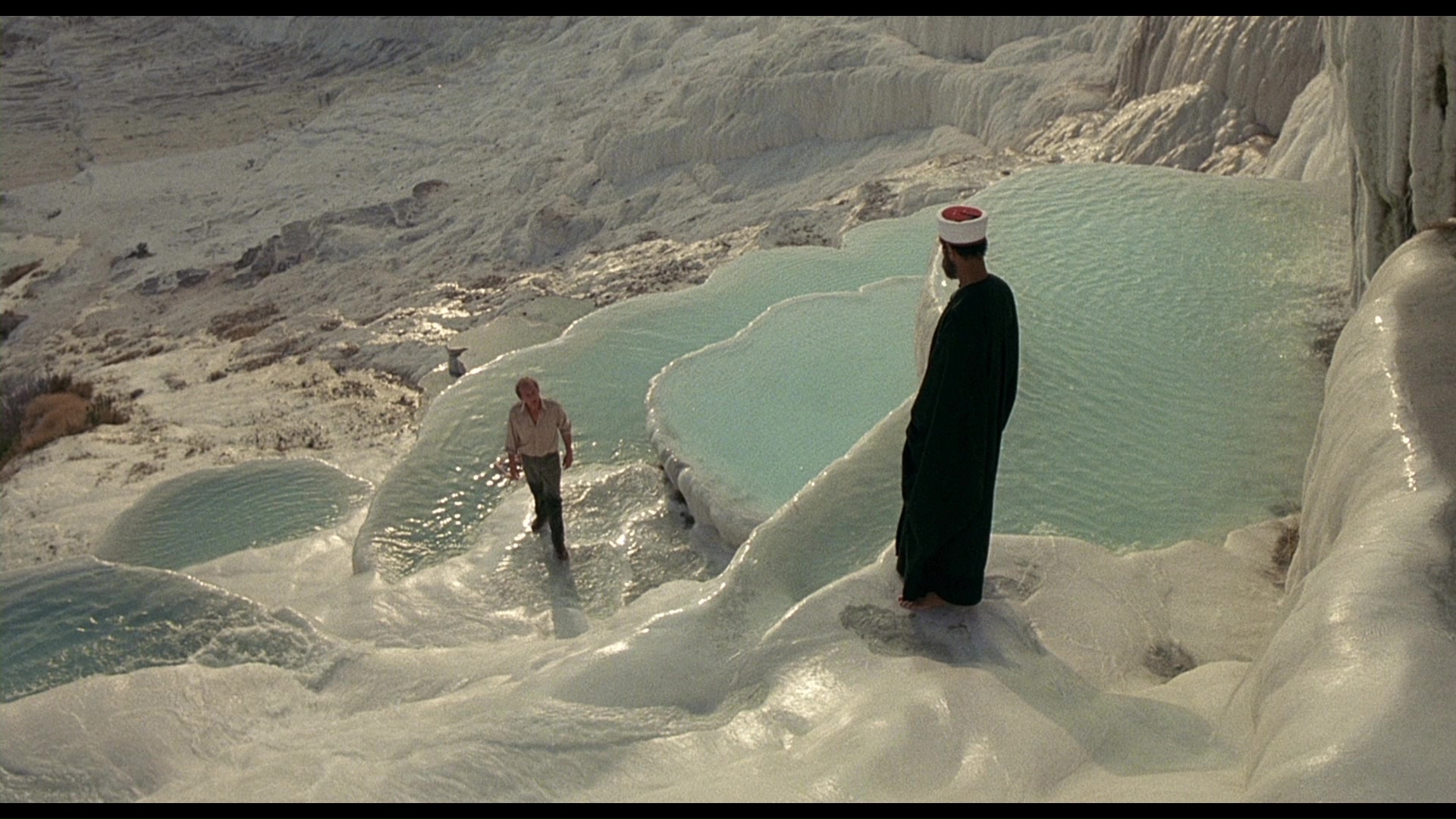 from his past work and more than a little bit of political turmoil, with TV commercials keeping him going in the interim. He also reveals which part was the most difficult to cast, and it's not the one you'd expect-- and there's even an anecdote about trying to cast Jack Palance, which would have resulted in a markedly different film! Shaban appears for a new interview in "The Silent One Speaks" (34m39s) for a comprehensive account of how he got the role (despite being convinced he'd be passed over) and was attracted to the deep, more abstract qualities that he finds are too rare in films now. He also explains how he ended up being transported around the imposing terrain and shares tales about some of the wilder moments during shooting, including a perilous cave fire. "In Another World" (16m52s) is a very welcome new interview with composer Colin Towns, who had already provided one of the best horror scores of all time with The Haunting of Julia and got to stretch himself with a world of unusual instruments and a heavy emphasis on the flute. The 2009 Firth interview is also carried over here, and a better presentation of the U.S. trailer is included along with separate galleries for location photography (48 images) from Saban's collection and a batch of (NSFW) stills and posters. The limited 3,000-unit edition also contains an insert
from his past work and more than a little bit of political turmoil, with TV commercials keeping him going in the interim. He also reveals which part was the most difficult to cast, and it's not the one you'd expect-- and there's even an anecdote about trying to cast Jack Palance, which would have resulted in a markedly different film! Shaban appears for a new interview in "The Silent One Speaks" (34m39s) for a comprehensive account of how he got the role (despite being convinced he'd be passed over) and was attracted to the deep, more abstract qualities that he finds are too rare in films now. He also explains how he ended up being transported around the imposing terrain and shares tales about some of the wilder moments during shooting, including a perilous cave fire. "In Another World" (16m52s) is a very welcome new interview with composer Colin Towns, who had already provided one of the best horror scores of all time with The Haunting of Julia and got to stretch himself with a world of unusual instruments and a heavy emphasis on the flute. The 2009 Firth interview is also carried over here, and a better presentation of the U.S. trailer is included along with separate galleries for location photography (48 images) from Saban's collection and a batch of (NSFW) stills and posters. The limited 3,000-unit edition also contains an insert  booklet with new liner notes by Dr. Ali Nobil Ahmad, writer Raficq Abdulla, and Shaban, plus a selection of reviews from the initial release.
booklet with new liner notes by Dr. Ali Nobil Ahmad, writer Raficq Abdulla, and Shaban, plus a selection of reviews from the initial release. with optional English SDH subtitles. Dehlavi pops up again in "Igniting the Fire" (19m15s), a different new interview covering his use of mystical elements and his own artistic pursuits stemming from his childhood love of painting. "The Silent One Speaks" and Qâf are ported over here from the British disc, while "Between the Sacred and the Profane" (65m37s) is a BFI lecture by Dr. Ali Nobil Ahmad about Dehlavi's work and the immense challenges of making films in Pakistan and how his films reflect the histories of South Asia and Great Britain. In "The Djinn Revisited" (24m29s), director Dalia Al Kury looks at the use of the famous fantastic character in Arabic pop culture stemming from generations of folklore with an often gruesome bent. In "Born of Fire and the Roots of Pakistani Horror" (11m123s), scholar Syeda Momina Masood looks at the national history of genre cinema which really started in the '60s (including The Living Corpse) with censor boards and politics often playing in a role in what could be depicted over the subsequent years. Also included are the trailer and an additional short film, Towers of Silence (51m16s), Dehlavi's 1975 black-and-white study of a little boy obsessed with death in both animal form (via ants, vultures, turtles, etc.) and humans.
with optional English SDH subtitles. Dehlavi pops up again in "Igniting the Fire" (19m15s), a different new interview covering his use of mystical elements and his own artistic pursuits stemming from his childhood love of painting. "The Silent One Speaks" and Qâf are ported over here from the British disc, while "Between the Sacred and the Profane" (65m37s) is a BFI lecture by Dr. Ali Nobil Ahmad about Dehlavi's work and the immense challenges of making films in Pakistan and how his films reflect the histories of South Asia and Great Britain. In "The Djinn Revisited" (24m29s), director Dalia Al Kury looks at the use of the famous fantastic character in Arabic pop culture stemming from generations of folklore with an often gruesome bent. In "Born of Fire and the Roots of Pakistani Horror" (11m123s), scholar Syeda Momina Masood looks at the national history of genre cinema which really started in the '60s (including The Living Corpse) with censor boards and politics often playing in a role in what could be depicted over the subsequent years. Also included are the trailer and an additional short film, Towers of Silence (51m16s), Dehlavi's 1975 black-and-white study of a little boy obsessed with death in both animal form (via ants, vultures, turtles, etc.) and humans. for his
for his  intense psychodramas like The Housemaid, Insect Woman, and Woman of Fire, South Korean director Kim Ki-Young was far along in his career when he made Io Island (or Ieodo, Iodo, or Ieoh Island). This one grabs your attention right away as the only folk horror film so far to open up with a discussion of the longevity of sperm in a dead body, which segues into a corporate presentation about the opening of Ioeh Island, a deluxe resort and spa named after a local mythical island in the area reputed to be the final destination for the souls of any drowned seamen. A dire warning from a reporter who goes missing during a nautical planning trip soon leads to a time-tripping mystery as one of the executives, Sun (Chung-chul), explores the nearest island and encounters the widows of those who never came back.
intense psychodramas like The Housemaid, Insect Woman, and Woman of Fire, South Korean director Kim Ki-Young was far along in his career when he made Io Island (or Ieodo, Iodo, or Ieoh Island). This one grabs your attention right away as the only folk horror film so far to open up with a discussion of the longevity of sperm in a dead body, which segues into a corporate presentation about the opening of Ioeh Island, a deluxe resort and spa named after a local mythical island in the area reputed to be the final destination for the souls of any drowned seamen. A dire warning from a reporter who goes missing during a nautical planning trip soon leads to a time-tripping mystery as one of the executives, Sun (Chung-chul), explores the nearest island and encounters the widows of those who never came back.  elements handled in a subdued fashion that makes it more effective. Well, at least that is until the big finale which suddenly gets very explicit in a way you'll never expect. Pretty much unseen outside of South Korea until a 2008 DVD release (which was subtitled and got bootlegged like crazy for a while), Io Island is a welcome addition
elements handled in a subdued fashion that makes it more effective. Well, at least that is until the big finale which suddenly gets very explicit in a way you'll never expect. Pretty much unseen outside of South Korea until a 2008 DVD release (which was subtitled and got bootlegged like crazy for a while), Io Island is a welcome addition  here and probably looks about as good as it could with a 2K scan of the original negative. It's a very soft-looking film, but grain is plentiful and it's likely true to the modest source. It's also extremely colorful at times, especially when that crazy red lighting pops up a few times. The DTS-H DA Korean 2.0 mono audio is fine and comes with optional English subtitles. Archivist and Korean film historian Ariel Schudson contributes a new commentary going into great detail about the film's dense structure, the director's films and narrative approaches, the joys of seeing "that" scene on the big screen, and lots more worth checking out. In "Shaman's Eyes" (26m25), Dr. Hyunseon Lee covers the recurring theme of shamanism in Korean films and connected projects including this one with concepts involving prophecy and divination resonating with local audiences. Finally you get the 2013 Taiwanese animated short film The Present (15m18s) by Joe Hseih, in which a man spending a late rainy night finds his sleep disturbed by a very unusual admirer who makes it very difficult for him to escape an island. It's quite good with a crazy Lovecraftian finale.
here and probably looks about as good as it could with a 2K scan of the original negative. It's a very soft-looking film, but grain is plentiful and it's likely true to the modest source. It's also extremely colorful at times, especially when that crazy red lighting pops up a few times. The DTS-H DA Korean 2.0 mono audio is fine and comes with optional English subtitles. Archivist and Korean film historian Ariel Schudson contributes a new commentary going into great detail about the film's dense structure, the director's films and narrative approaches, the joys of seeing "that" scene on the big screen, and lots more worth checking out. In "Shaman's Eyes" (26m25), Dr. Hyunseon Lee covers the recurring theme of shamanism in Korean films and connected projects including this one with concepts involving prophecy and divination resonating with local audiences. Finally you get the 2013 Taiwanese animated short film The Present (15m18s) by Joe Hseih, in which a man spending a late rainy night finds his sleep disturbed by a very unusual admirer who makes it very difficult for him to escape an island. It's quite good with a crazy Lovecraftian finale.  Then we hop over to Saudi Arabia on the same disc for 2019's Scales, which continues
Then we hop over to Saudi Arabia on the same disc for 2019's Scales, which continues  the idea of female-centered nautical peril. Here we open with a little baby about to be sacrificed via drowning into the ocean as part of a village ritual, but at the last second, the father responsible, Muthana (Al Farhan), decides to save her. Flash forward twelve years as the surviving child, Hayat (Hajjar), has become an outcast because of her father's decision and the presence of peculiar scales on her feet. Now a second child is on the way that they hope will provide a daughter to restore the family's honor, but fate has more tricks in store as the true reason for this ritual becomes clear.
the idea of female-centered nautical peril. Here we open with a little baby about to be sacrificed via drowning into the ocean as part of a village ritual, but at the last second, the father responsible, Muthana (Al Farhan), decides to save her. Flash forward twelve years as the surviving child, Hayat (Hajjar), has become an outcast because of her father's decision and the presence of peculiar scales on her feet. Now a second child is on the way that they hope will provide a daughter to restore the family's honor, but fate has more tricks in store as the true reason for this ritual becomes clear.  (including Lovecraft again) but the execution is quite fresh with a focus on how one generation can scar the next through habitual practices that only
(including Lovecraft again) but the execution is quite fresh with a focus on how one generation can scar the next through habitual practices that only  cause harm. Given a very marginal theatrical release in the U.S., it looks very impressive here with an immersive DTS-HD 5.1 track to match (with the usual optional English subs). Janisse returns for "Telling Our Stories" (35m2s) as moderator for a teleconference conversation between director Shahad Ameen and producer Rula Nasser about the Saudi Arabian film industry, the inspiration for the story, its reception, and the evolution of filmmaking in the area to this day. Also included are a trailer and a 2016 short film by Damien Ournouri, Kindil (40m2s), in which a horrifying drowning murder during a family's beach road trip outing leads to revenge from beyond the grave. Superficially this seems like an E.C. Comics-style horror payback story, but it definitely goes more into social outrage territory after the halfway point with an interesting resolution that isn't quite what you'd expect.
cause harm. Given a very marginal theatrical release in the U.S., it looks very impressive here with an immersive DTS-HD 5.1 track to match (with the usual optional English subs). Janisse returns for "Telling Our Stories" (35m2s) as moderator for a teleconference conversation between director Shahad Ameen and producer Rula Nasser about the Saudi Arabian film industry, the inspiration for the story, its reception, and the evolution of filmmaking in the area to this day. Also included are a trailer and a 2016 short film by Damien Ournouri, Kindil (40m2s), in which a horrifying drowning murder during a family's beach road trip outing leads to revenge from beyond the grave. Superficially this seems like an E.C. Comics-style horror payback story, but it definitely goes more into social outrage territory after the halfway point with an interesting resolution that isn't quite what you'd expect.  Japanese ghost story time with 1968's Bakeneko: A Vengeful Spirit, better
Japanese ghost story time with 1968's Bakeneko: A Vengeful Spirit, better  known for its literal translation and onetime DVD title Ghost Cat of the Cursed Pond. This is one of the many variations on the bakeneko or "ghost cat" strain of spooky tales, which includes such diverse films as Kuroneko, A Haunted Turkish Bathhouse, and The Ghost Cat of Ouma Crossing. These feudal supernatural melodramas are always a good time, and this one's no exception with sparing but great use of that old standby, a vengeful woman who strikes back after death. Here the mayhem begins with the brutal ladder climbing of servant Nabeshima Naoshige (Uchida) who schemes his way into replacing his lord... including his wife, who responds by drowning herself and her cat in a lake rather than marrying the traitor after her husband is smothered to death. Drunk with power for a decade, Naoshige eventually sets his sights on the very unwilling Yujiki (Mikage)
known for its literal translation and onetime DVD title Ghost Cat of the Cursed Pond. This is one of the many variations on the bakeneko or "ghost cat" strain of spooky tales, which includes such diverse films as Kuroneko, A Haunted Turkish Bathhouse, and The Ghost Cat of Ouma Crossing. These feudal supernatural melodramas are always a good time, and this one's no exception with sparing but great use of that old standby, a vengeful woman who strikes back after death. Here the mayhem begins with the brutal ladder climbing of servant Nabeshima Naoshige (Uchida) who schemes his way into replacing his lord... including his wife, who responds by drowning herself and her cat in a lake rather than marrying the traitor after her husband is smothered to death. Drunk with power for a decade, Naoshige eventually sets his sights on the very unwilling Yujiki (Mikage)  who starts to follow the footsteps of the past and unleashes a curse with a mounting
who starts to follow the footsteps of the past and unleashes a curse with a mounting  body count.
body count. As expected it looks and sounds faultless, with the DTS-HD MA 2.0 Japanese mono track up to par as well with optional English subtitles. The always thorough Jasper Sharp delivers a new audio
As expected it looks and sounds faultless, with the DTS-HD MA 2.0 Japanese mono track up to par as well with optional English subtitles. The always thorough Jasper Sharp delivers a new audio  commentary laying out the origins of the story, the context for the ghost cat films, the history behind director Yoshihiro Ishikawa, and pretty much anything else you could want to know. On the broader side, the featurette "Scratched: A History of the Japanese Ghost Cat" (22m53s) features Miyoko Shimura, Zack Davisson, and Michael Crandol talking about the various permutations of this narrative device and its social implications, including the satisfaction of women who had little recourse for payback in life unleashing it from the netherworld instead. Also included are the subtitled Japanese trailer, a reading of the folk tale "The Vampire Cat" (9m11s) by Tomoko Komura with music by Timothy Fife, and Nayoyuka Niima's 2010 short, Man-Eater Mountain (27m38s), a visually striking kamishibai (or "paper drama") animated horror tale about a murder investigation that quickly leads to an unholy world of monsters at the titular location.
commentary laying out the origins of the story, the context for the ghost cat films, the history behind director Yoshihiro Ishikawa, and pretty much anything else you could want to know. On the broader side, the featurette "Scratched: A History of the Japanese Ghost Cat" (22m53s) features Miyoko Shimura, Zack Davisson, and Michael Crandol talking about the various permutations of this narrative device and its social implications, including the satisfaction of women who had little recourse for payback in life unleashing it from the netherworld instead. Also included are the subtitled Japanese trailer, a reading of the folk tale "The Vampire Cat" (9m11s) by Tomoko Komura with music by Timothy Fife, and Nayoyuka Niima's 2010 short, Man-Eater Mountain (27m38s), a visually striking kamishibai (or "paper drama") animated horror tale about a murder investigation that quickly leads to an unholy world of monsters at the titular location.  On the same disc is the outstanding 1999 Thai horror film Nang Nak, which was
On the same disc is the outstanding 1999 Thai horror film Nang Nak, which was  something of an international cult favorite on the specialty cinema circuit in the early '00s but has largely fallen out of the public eye since then. A reworking of a familiar, oft-adapted local ghost story, it's a tragic 19th-century horror romance in which Mak (Kraibutr) returns home to his village from combat to his wife, Nak (Jaroenpura), and their child who was born in his absence. The locals are unsettled to see them reunite since Nak had actually died several months before, but any attempts to warn Mak result in death. As Mak gradually comes to realize the truth, drastic steps must be taken to help Nak come to terms with her determination to remain with her husband at any cost.
something of an international cult favorite on the specialty cinema circuit in the early '00s but has largely fallen out of the public eye since then. A reworking of a familiar, oft-adapted local ghost story, it's a tragic 19th-century horror romance in which Mak (Kraibutr) returns home to his village from combat to his wife, Nak (Jaroenpura), and their child who was born in his absence. The locals are unsettled to see them reunite since Nak had actually died several months before, but any attempts to warn Mak result in death. As Mak gradually comes to realize the truth, drastic steps must be taken to help Nak come to terms with her determination to remain with her husband at any cost.  green foliage and ever-present water, the perfect backdrop for a film that
green foliage and ever-present water, the perfect backdrop for a film that  kicked off a wave of Thai horror films that continues to this day. Past video releases of this one weren't all that impressive, with the Severin Blu-ray standing as the best of the bunch; the notes simply state that this is from an HD master provided by the licensor with the label doing additional color correction work. Even theatrically this had a very aggressive color scheme and looked somewhat soft, which is what you get here as well and was presumably the intended aesthetic. The Thai audio is presented in very active DTS-HD MA 5.1 and 2.0 stereo mixes with optional English subtitles, plus an audio commentary by director Mattie Do and scholar Katarzyna Ancuta about the long history of the source story, the role of horror in Thai pop culture, and background about the location, among plenty of other topics. In "Love and Impermanence: Nang Nak and the Rebirth of Thai Cinema" (22m26s), director Nonzee Nimibutr talks about how the film came together at a transitional period in Thai cinema, how the decision was made to change perspectives on the ghost character from the familiar version, and what impact its release had on filmmaking in the area. A trailer is also included.
kicked off a wave of Thai horror films that continues to this day. Past video releases of this one weren't all that impressive, with the Severin Blu-ray standing as the best of the bunch; the notes simply state that this is from an HD master provided by the licensor with the label doing additional color correction work. Even theatrically this had a very aggressive color scheme and looked somewhat soft, which is what you get here as well and was presumably the intended aesthetic. The Thai audio is presented in very active DTS-HD MA 5.1 and 2.0 stereo mixes with optional English subtitles, plus an audio commentary by director Mattie Do and scholar Katarzyna Ancuta about the long history of the source story, the role of horror in Thai pop culture, and background about the location, among plenty of other topics. In "Love and Impermanence: Nang Nak and the Rebirth of Thai Cinema" (22m26s), director Nonzee Nimibutr talks about how the film came together at a transitional period in Thai cinema, how the decision was made to change perspectives on the ghost character from the familiar version, and what impact its release had on filmmaking in the area. A trailer is also included.  we next hop to Indonesia for the entirety of disc seven, a salute to the country's
we next hop to Indonesia for the entirety of disc seven, a salute to the country's  most famous horror star, Suzzanna, who passed away in 2008 at the age of 66 and remains so popular that tribute films are still being made for international streaming. Along with 1981's The Queen of Black Magic, one of her most popular films is Sundelbolong (also known as Ghost with Hole and Devil Woman), presented here on disc seven in its first North American release of any kind. Suzzanna takes on two roles here for the story of Alisa, a onetime prostitute now married to the often absent Hendarto (The Warrior's Prima) and devoted to spending her time embroidering. An opportunity to turn her work into a business instead lands her in the talons of her ruthless former madam, Mami (Pelupessy), whose thugs rape Alisa when she refuses to go back to work for them. Finding out she's pregnant, Alisa dies during an attempt at an abortion and turns into a terrifying creature bent on avenging herself on everyone who wronged her.
most famous horror star, Suzzanna, who passed away in 2008 at the age of 66 and remains so popular that tribute films are still being made for international streaming. Along with 1981's The Queen of Black Magic, one of her most popular films is Sundelbolong (also known as Ghost with Hole and Devil Woman), presented here on disc seven in its first North American release of any kind. Suzzanna takes on two roles here for the story of Alisa, a onetime prostitute now married to the often absent Hendarto (The Warrior's Prima) and devoted to spending her time embroidering. An opportunity to turn her work into a business instead lands her in the talons of her ruthless former madam, Mami (Pelupessy), whose thugs rape Alisa when she refuses to go back to work for them. Finding out she's pregnant, Alisa dies during an attempt at an abortion and turns into a terrifying creature bent on avenging herself on everyone who wronged her.  Indonesian horror (or the genre in general from Southeast Asia), it shouldn't be a surprise that Sundelbolong has a different pace from what many viewers expect with the
Indonesian horror (or the genre in general from Southeast Asia), it shouldn't be a surprise that Sundelbolong has a different pace from what many viewers expect with the  more downbeat first half feeling more like a dark drama with a lot of implied (but not explicit) sleaze. Things shift dramatically after that though once the body count begins, with lots of outrageous mayhem including what Joe Bob Briggs might term "tombstone fu." Suzzanna is obviously the main attraction here with her searing stare, and it's fun seeing her in one of the four films she made with Prima. The HD master provided to Severin for the Blu-ray release is okay and about on par with many other Indonesian films of the period, but don't expect to be blown away as it obviously hasn't been kept in the best of conditions and has some very heavy DNR; the Indonesian DTS-HD MA 2.0 mono track (with subs) sounds good. In any shape though, it's great to finally have in a legit release. In the featurette "Hantu Retribution: Female Ghosts of the Malay Archipelago" (28m43s), Katrina
more downbeat first half feeling more like a dark drama with a lot of implied (but not explicit) sleaze. Things shift dramatically after that though once the body count begins, with lots of outrageous mayhem including what Joe Bob Briggs might term "tombstone fu." Suzzanna is obviously the main attraction here with her searing stare, and it's fun seeing her in one of the four films she made with Prima. The HD master provided to Severin for the Blu-ray release is okay and about on par with many other Indonesian films of the period, but don't expect to be blown away as it obviously hasn't been kept in the best of conditions and has some very heavy DNR; the Indonesian DTS-HD MA 2.0 mono track (with subs) sounds good. In any shape though, it's great to finally have in a legit release. In the featurette "Hantu Retribution: Female Ghosts of the Malay Archipelago" (28m43s), Katrina  Irawati Graham and Rosalind Galt cover the popularity of
Irawati Graham and Rosalind Galt cover the popularity of  intimidating supernatural women running through many genre films of the time including a slew of archival film clips from titles that would be great to see in their entirety someday. Also here is Graham's 2013 short film White Song (11m21s) about an artist whose emotional trauma becomes a ghostly magnet.
intimidating supernatural women running through many genre films of the time including a slew of archival film clips from titles that would be great to see in their entirety someday. Also here is Graham's 2013 short film White Song (11m21s) about an artist whose emotional trauma becomes a ghostly magnet.  connections to her professional life, the
connections to her professional life, the  tiered system of theatrical releasing and the target audience for these films, and much more. You get tons of film clips both familiar and very obscure along with archival interview excerpts with Suzzanna herself, and it's enough to make you want to plan a mini-film festival when it's done. The glimpses of Indonesian filmgoing culture are also great to see here, including an outdoor screening that looks like a blast. Also included here are the trailer and a video conference chat between Gregory and co-producer Ekky Imanjay (18m55s) about Suzzanna's enduring appeal, the logistics of putting the doc together, its importance to film fans, and the unique qualities of Indonesian horror.
tiered system of theatrical releasing and the target audience for these films, and much more. You get tons of film clips both familiar and very obscure along with archival interview excerpts with Suzzanna herself, and it's enough to make you want to plan a mini-film festival when it's done. The glimpses of Indonesian filmgoing culture are also great to see here, including an outdoor screening that looks like a blast. Also included here are the trailer and a video conference chat between Gregory and co-producer Ekky Imanjay (18m55s) about Suzzanna's enduring appeal, the logistics of putting the doc together, its importance to film fans, and the unique qualities of Indonesian horror. 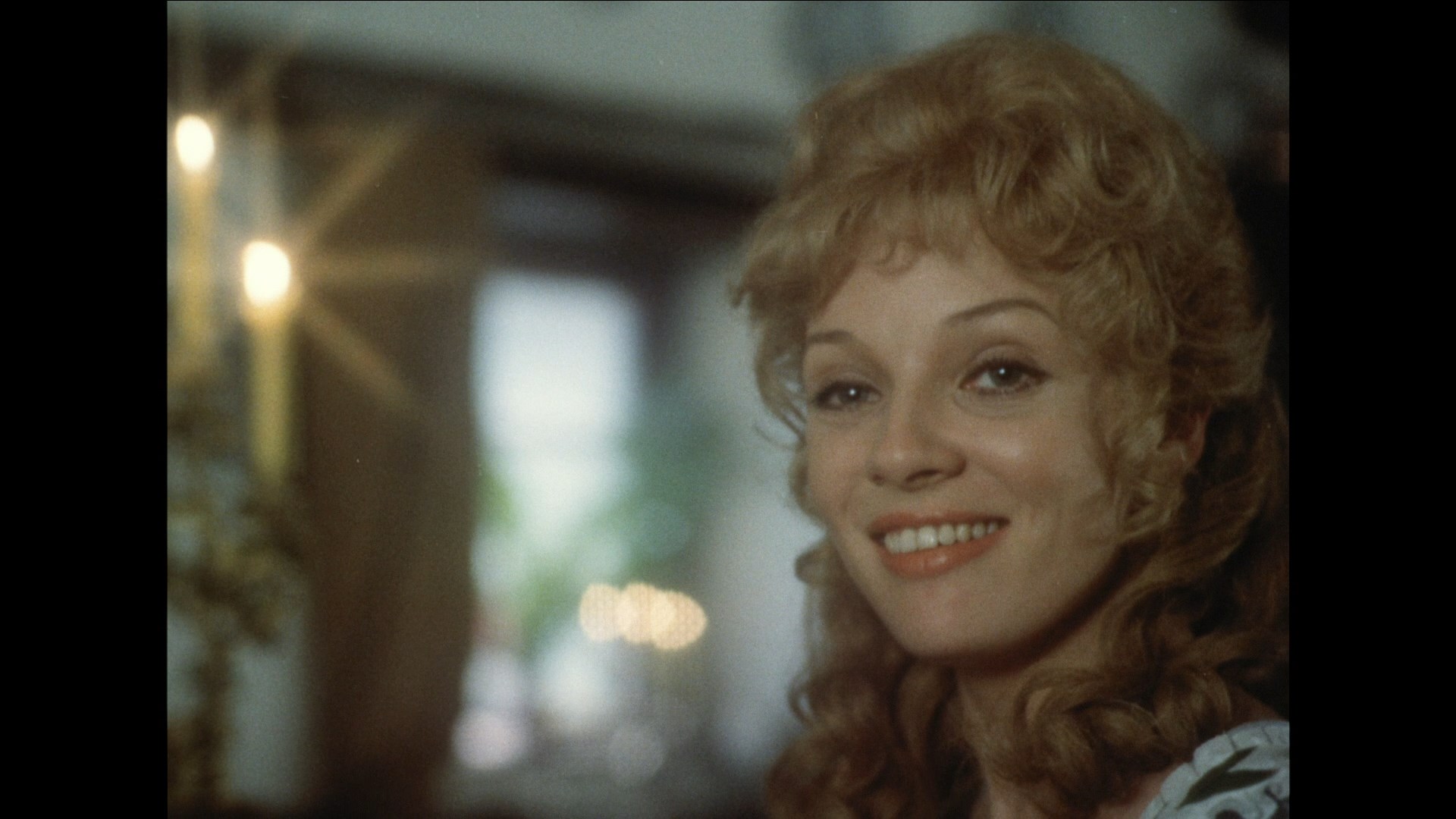 work of Czechoslovak director Juraj Herz is studded
work of Czechoslovak director Juraj Herz is studded 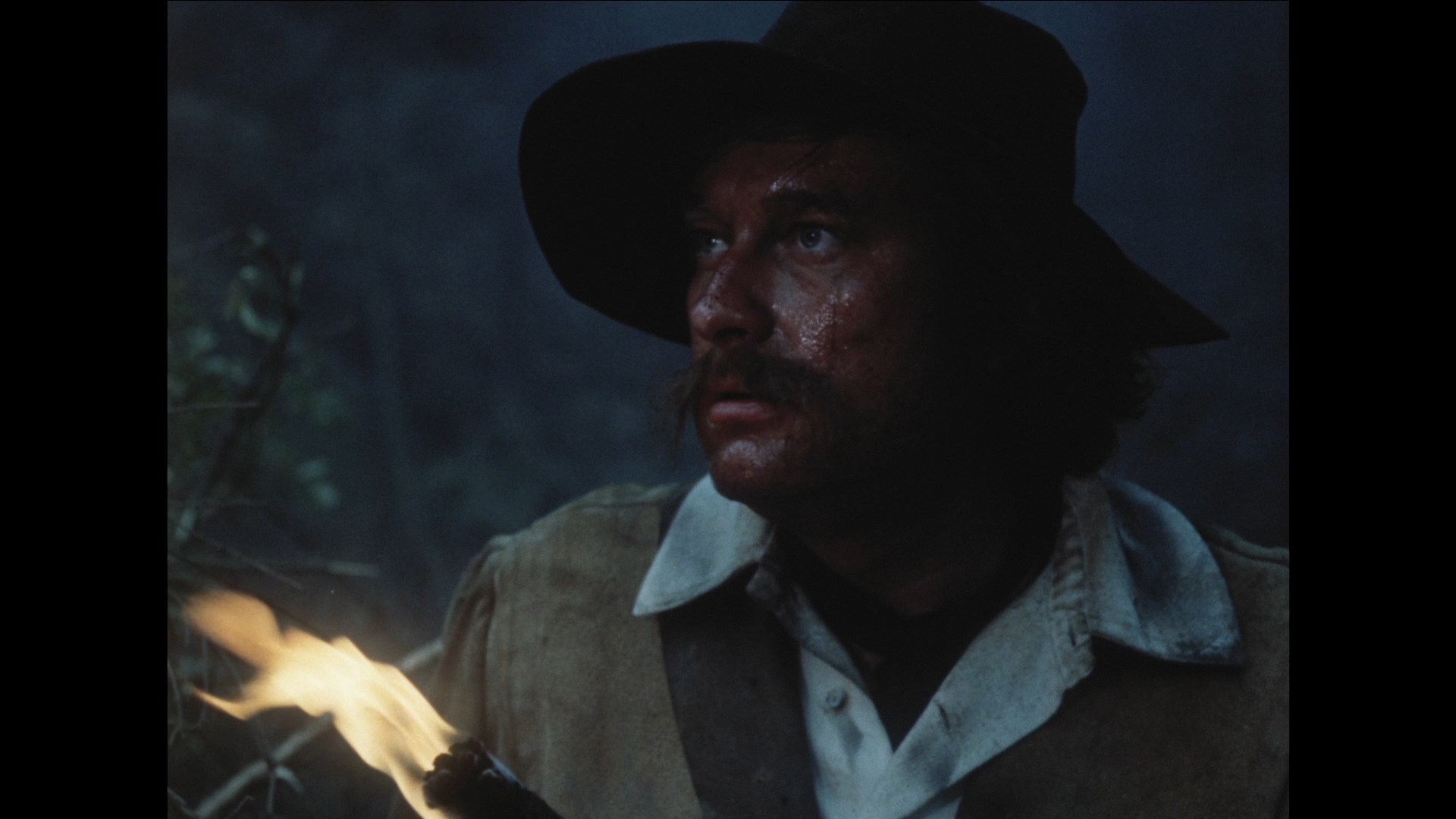 with plenty of beguiling surprises the rest of the world has been increasingly enjoying at home in recent years, ranging from the unqualified masterpiece The Cremator to the delirious horror chamber piece Morgiana and the later vampire-consumerism satire Ferat Vampire. While many of his films have yet to reach English-speaking viewers, one that was on cult movie fans' radars for quite a while was Panna a netvor (more literally The Virgin and the Monster but referred to now more logically as Beauty and the Beast), a very spooky and gorgeous adaptation of the well-known fairy tale. Getting a subtitled version was virtually impossible until it popped up years ago on Australian TV (the source for many gray market copies since then), and eventually it received an HD transfer in 2018 from the Czech National Film Archive that floated around on European Blu-ray for a few years without any English-friendly language options. That situation was finally rectified in 2021 courtesy of a Second Run edition in the U.K., while Severin upped the ante with its own presentation here on disc eight.
with plenty of beguiling surprises the rest of the world has been increasingly enjoying at home in recent years, ranging from the unqualified masterpiece The Cremator to the delirious horror chamber piece Morgiana and the later vampire-consumerism satire Ferat Vampire. While many of his films have yet to reach English-speaking viewers, one that was on cult movie fans' radars for quite a while was Panna a netvor (more literally The Virgin and the Monster but referred to now more logically as Beauty and the Beast), a very spooky and gorgeous adaptation of the well-known fairy tale. Getting a subtitled version was virtually impossible until it popped up years ago on Australian TV (the source for many gray market copies since then), and eventually it received an HD transfer in 2018 from the Czech National Film Archive that floated around on European Blu-ray for a few years without any English-friendly language options. That situation was finally rectified in 2021 courtesy of a Second Run edition in the U.K., while Severin upped the ante with its own presentation here on disc eight.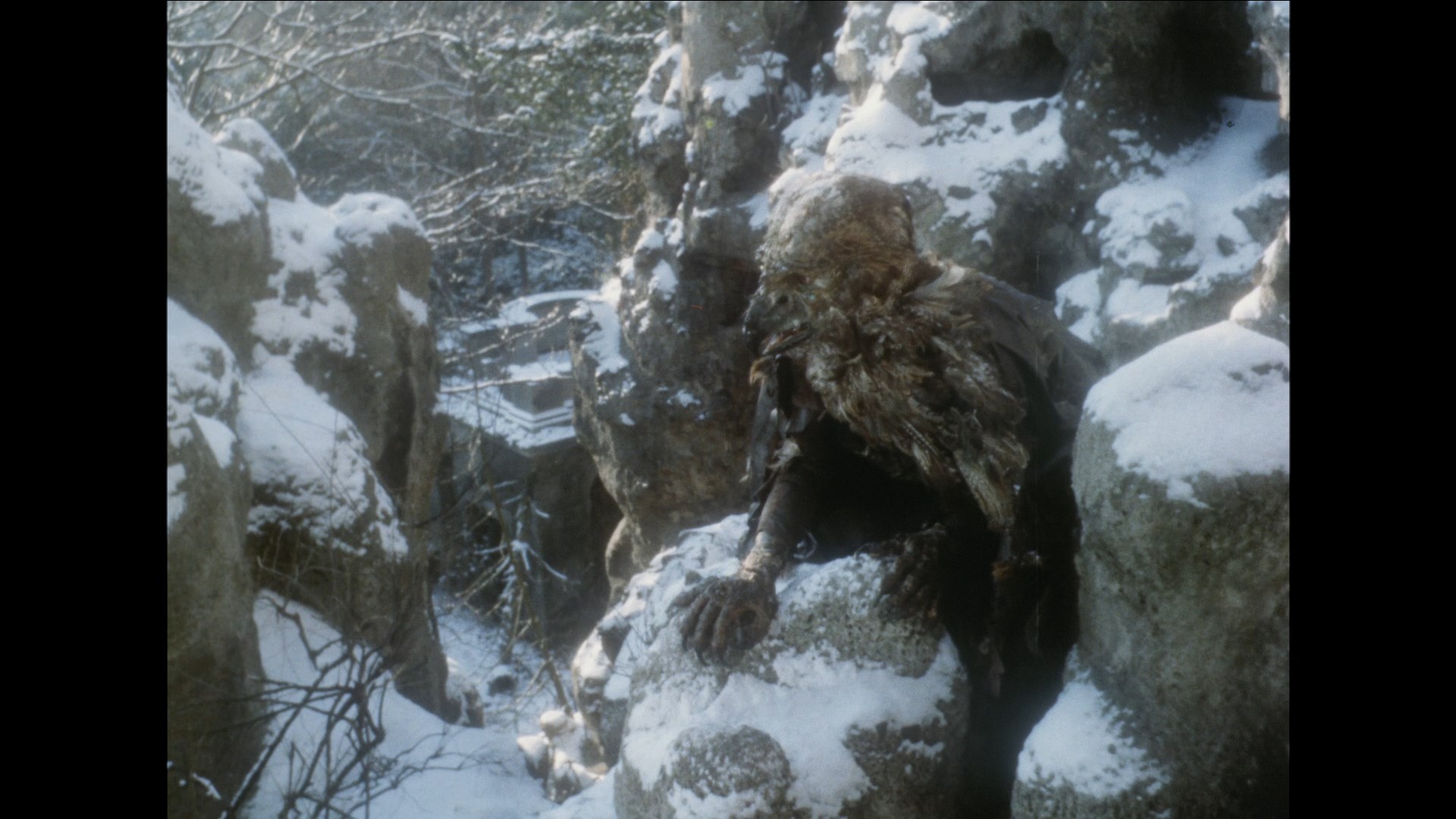 In a medieval village, Julia (Studenková) is devoted to her merchant father Otec (Voska) but taunted by her two hateful half-sisters, Gabinka (Brejchová) and Malinka (Kocúriková). When the family is
In a medieval village, Julia (Studenková) is devoted to her merchant father Otec (Voska) but taunted by her two hateful half-sisters, Gabinka (Brejchová) and Malinka (Kocúriková). When the family is  forced into dire straits, her father sets off through a foreboding forest to sell the one valuable left, a portrait of Julia's mother, only to fall into the clutches of the Beast (Harapes) who lives under a horrifying curse that gives him an animalistic appearance complete with a bird-like head. After Otec is sentenced to death and sent home to say goodbye for an infraction involving a white rose, Julia offers to take his place and journeys to the decaying, snow-covered castle where the Beast tries to restrain his recurring murderous urges in her presence...
forced into dire straits, her father sets off through a foreboding forest to sell the one valuable left, a portrait of Julia's mother, only to fall into the clutches of the Beast (Harapes) who lives under a horrifying curse that gives him an animalistic appearance complete with a bird-like head. After Otec is sentenced to death and sent home to say goodbye for an infraction involving a white rose, Julia offers to take his place and journeys to the decaying, snow-covered castle where the Beast tries to restrain his recurring murderous urges in her presence...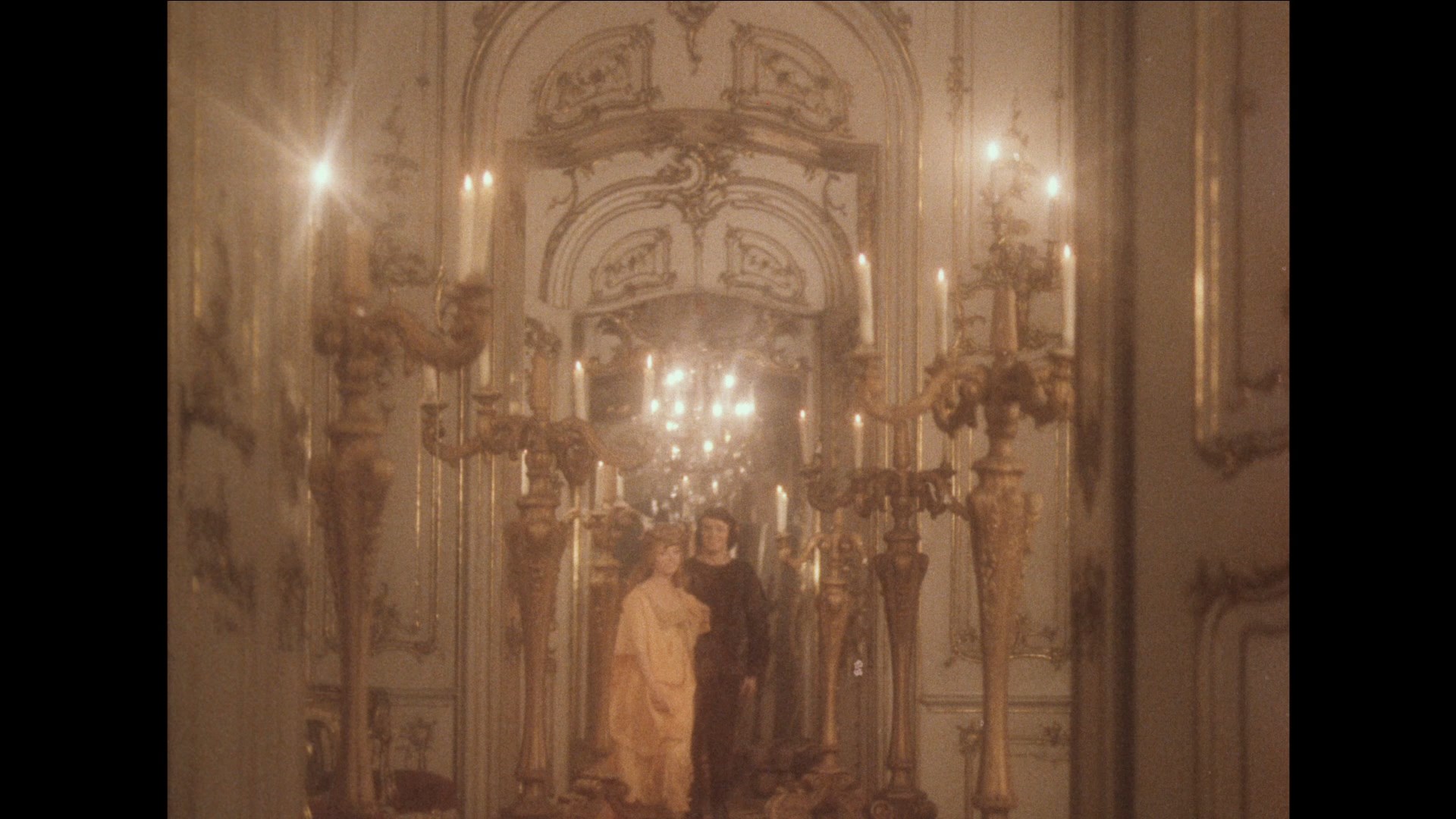 pulling no punches about the
pulling no punches about the 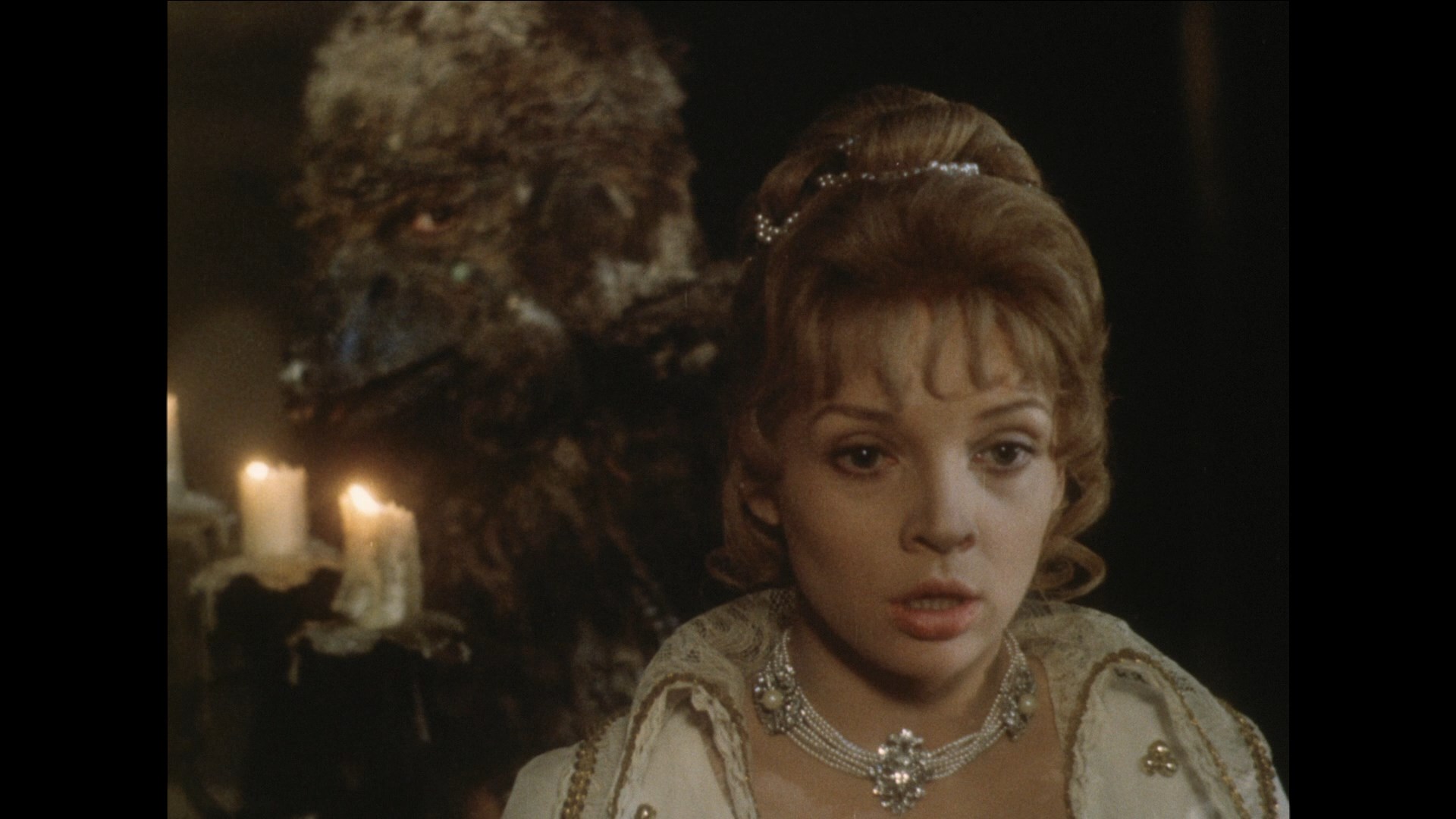 corruption of materialism or the violent urges of its haunted prince. The decision to cast gifted dancer Vlastimil Harapes as the Beast (and showing his real face only twice, very briefly) pays off with a striking interpretation of the familiar character, here looking and moving very differently from the furry, regal creation we usually see. Also noteworthy is the chilling organ-heavy score by Petr Hapka which provides startling musical cues every time something supernatural is about to occur.
corruption of materialism or the violent urges of its haunted prince. The decision to cast gifted dancer Vlastimil Harapes as the Beast (and showing his real face only twice, very briefly) pays off with a striking interpretation of the familiar character, here looking and moving very differently from the furry, regal creation we usually see. Also noteworthy is the chilling organ-heavy score by Petr Hapka which provides startling musical cues every time something supernatural is about to occur. point, Herz's background and censorship wrangling, the shared traits with other adaptations as well as the distinct differences, the Gothic elements in the visual design, the advantages of the graceful Harapes' casting, and plenty more.
point, Herz's background and censorship wrangling, the shared traits with other adaptations as well as the distinct differences, the Gothic elements in the visual design, the advantages of the graceful Harapes' casting, and plenty more. 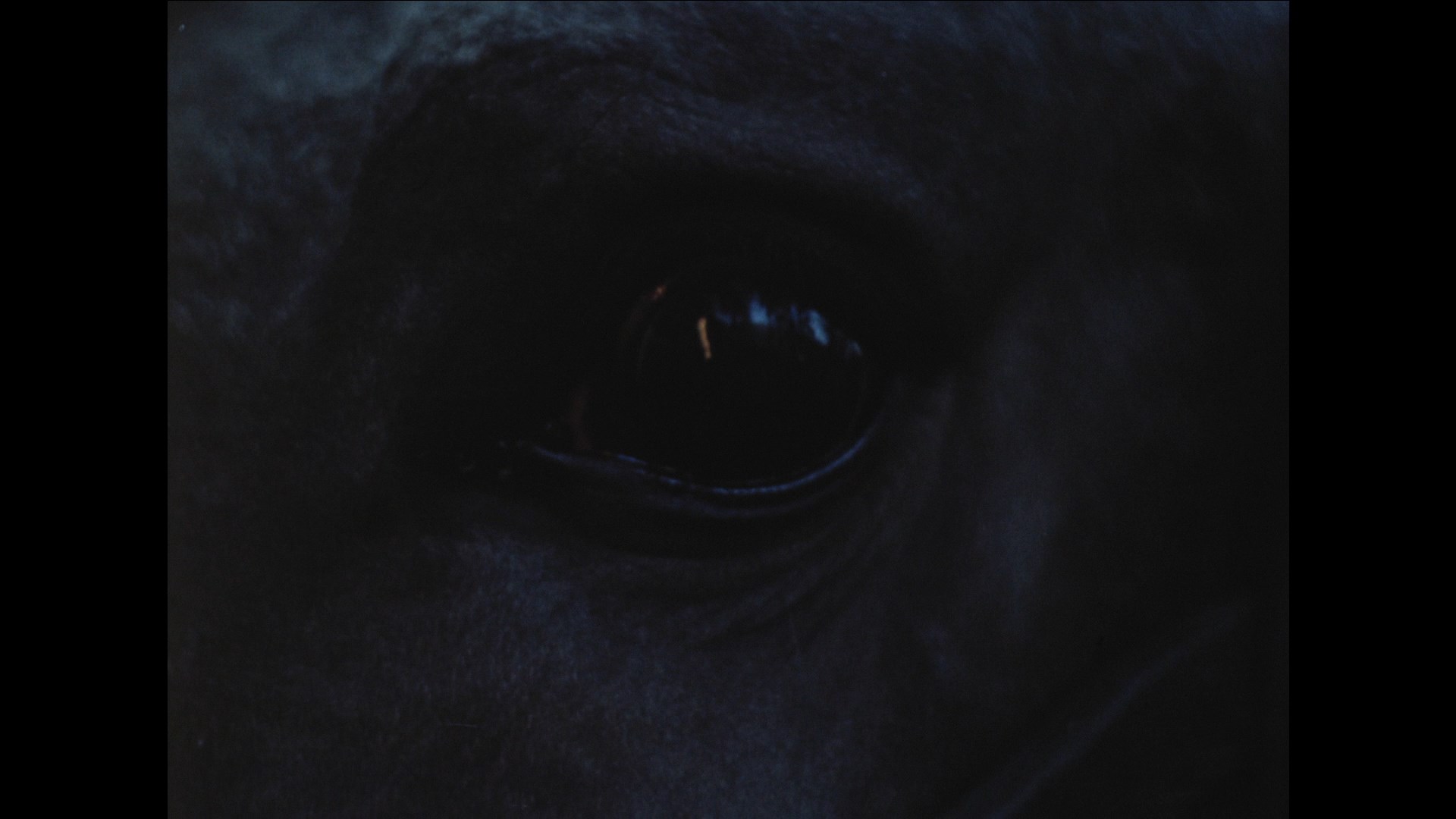 Also included is 1964's František Hrubín (9m7s), a stylized short film with the titular writer and poet, who served as co-screenwriter on the main feature, ruminating on his own life cycle compared to the landscape around him. The disc also comes with an insert booklet with a thorough essay by Jonathan Owen about Herz's initially apprehensive approach to the material, his lack of enthusiasm for fairy tales, and an in-depth reading of the symbolism recurring throughout the storyline.
Also included is 1964's František Hrubín (9m7s), a stylized short film with the titular writer and poet, who served as co-screenwriter on the main feature, ruminating on his own life cycle compared to the landscape around him. The disc also comes with an insert booklet with a thorough essay by Jonathan Owen about Herz's initially apprehensive approach to the material, his lack of enthusiasm for fairy tales, and an in-depth reading of the symbolism recurring throughout the storyline. the financing, the casting, memories from the set, the background of the pivotal painting seen in the film, the problem with
the financing, the casting, memories from the set, the background of the pivotal painting seen in the film, the problem with  burning one of your sets for a scene, and more.
burning one of your sets for a scene, and more.  preceded Martin (and the title should tip you off what happened to them), which leads
preceded Martin (and the title should tip you off what happened to them), which leads  to a dangerous encounter at the center of Aldobrandini's realm.
to a dangerous encounter at the center of Aldobrandini's realm.  of his approach despite
of his approach despite  changing styles to varying degrees with each film; she also goes through the difficulty of nailing down what folk horror actually is and goes through the appeal of these films outside their home country including enduring popularity in countries like Germany. In "The Uncanny Valley of the Dolls: The History and Liminality of Dolls, Puppets and Mannequins" (13m16s), Dr. Emily LeQuesne lays out he history of little artificial humans in uncanny narratives as well as the real-life persecution they invoked at points in history. Finally in "The Curious Case Of Juraj Herz And The Švankmajers" (25m19s), Czech film programmer Cerise Howard analyzes the symbiosis between the director and the animators on this film who had a major artistic impact in their own right on stop-motion animation, poster art, and more through a formidable body of work that owes much to the European horror tradition.
changing styles to varying degrees with each film; she also goes through the difficulty of nailing down what folk horror actually is and goes through the appeal of these films outside their home country including enduring popularity in countries like Germany. In "The Uncanny Valley of the Dolls: The History and Liminality of Dolls, Puppets and Mannequins" (13m16s), Dr. Emily LeQuesne lays out he history of little artificial humans in uncanny narratives as well as the real-life persecution they invoked at points in history. Finally in "The Curious Case Of Juraj Herz And The Švankmajers" (25m19s), Czech film programmer Cerise Howard analyzes the symbiosis between the director and the animators on this film who had a major artistic impact in their own right on stop-motion animation, poster art, and more through a formidable body of work that owes much to the European horror tradition. BEAUTY AND THE BEAST: Severin (Blu-ray)
BEAUTY AND THE BEAST: Second Run (Blu-ray)
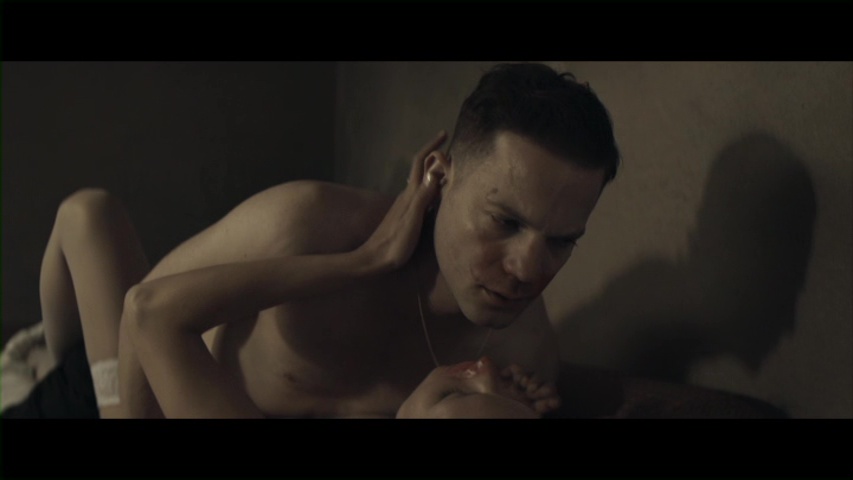 horror that got a warm
horror that got a warm 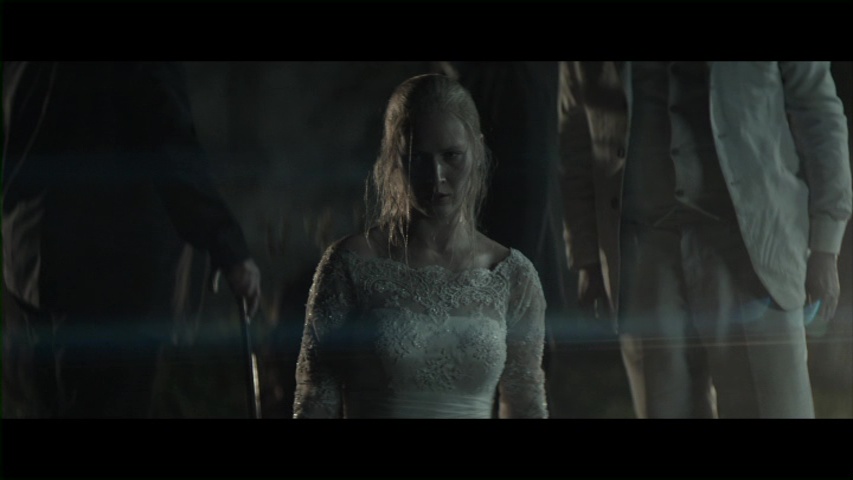 reception at Fantastic Fest back in the day, 2015's Demon is sort of a more subdued ghostly version of [REC] 3, it marked a rare detour into horror for director Marcin Wrona who tragically committed suicide after the film's completion at the age of 42. Extremely well made and featuring some compelling historical subtext to boot, the film follows the ill-fated wedding of foreigner Peter (Israeli actor Tiran) to Polish-speaking Zaneta (Zulewska), whose upper class family is helping to throw a relatively lavish ceremony on their family premises despite the fact that the couple had mainly only known each other online. After Peter discovers skeletal remains on the grounds, he starts to behave very strangely and sees visions of a woman in a wedding dress -- a harbinger of the disaster that's about to befall him.
reception at Fantastic Fest back in the day, 2015's Demon is sort of a more subdued ghostly version of [REC] 3, it marked a rare detour into horror for director Marcin Wrona who tragically committed suicide after the film's completion at the age of 42. Extremely well made and featuring some compelling historical subtext to boot, the film follows the ill-fated wedding of foreigner Peter (Israeli actor Tiran) to Polish-speaking Zaneta (Zulewska), whose upper class family is helping to throw a relatively lavish ceremony on their family premises despite the fact that the couple had mainly only known each other online. After Peter discovers skeletal remains on the grounds, he starts to behave very strangely and sees visions of a woman in a wedding dress -- a harbinger of the disaster that's about to befall him. chiller as well as a potent slice of social commentary about societal trauma and ghosts so baked into the soil that they never go away.
chiller as well as a potent slice of social commentary about societal trauma and ghosts so baked into the soil that they never go away.  The film got a U.K. DVD release a while back from Terracotta featuring 5.1 and 2.0 Dolby Digital options for the original Polish audio (which has some fun directional effects), with optional English subtitles. The sole extra is a 3m30s photo gallery. The Severin Blu-ray has DTS-HD MA 5.1 and 2.0 Polish options (both sound good), this time with burned-in subtitles for some reason. The film comes with an intro by Slavic horror scholar Dr. Agnieszka Jeżyk (10m28s) about Wrona's short life and career as well as the film's place in the Polish genre pantheon, and there's a new audio commentary by Daniel Birdand Manuela Lazić about cultural terminology related to the Holocaust, the character progression in this film as a larger metaphor, the difference between staging for cinema versus theater despite working in a limited setting like this, and the backgrounds of the major players. In the video essay "In the Shadow of the Dybbuk" (17m51s), author Peter Bebergal and filmmaker Stephen Broomer present a look at the depiction of possession in this film as a tragic variation on a mythical figure running through centuries of Jewish storytelling. Finally you get a trailer and the 2019 short film Dibbuk (35m22s) by Dayan D. Oaulid, a very different kind of exorcism story focusing on Orthodox Jewish customs.
The film got a U.K. DVD release a while back from Terracotta featuring 5.1 and 2.0 Dolby Digital options for the original Polish audio (which has some fun directional effects), with optional English subtitles. The sole extra is a 3m30s photo gallery. The Severin Blu-ray has DTS-HD MA 5.1 and 2.0 Polish options (both sound good), this time with burned-in subtitles for some reason. The film comes with an intro by Slavic horror scholar Dr. Agnieszka Jeżyk (10m28s) about Wrona's short life and career as well as the film's place in the Polish genre pantheon, and there's a new audio commentary by Daniel Birdand Manuela Lazić about cultural terminology related to the Holocaust, the character progression in this film as a larger metaphor, the difference between staging for cinema versus theater despite working in a limited setting like this, and the backgrounds of the major players. In the video essay "In the Shadow of the Dybbuk" (17m51s), author Peter Bebergal and filmmaker Stephen Broomer present a look at the depiction of possession in this film as a tragic variation on a mythical figure running through centuries of Jewish storytelling. Finally you get a trailer and the 2019 short film Dibbuk (35m22s) by Dayan D. Oaulid, a very different kind of exorcism story focusing on Orthodox Jewish customs.  here after a 2018 release from
here after a 2018 release from  Oscilloscope. In a desolate village, the lycanthrope Liina is being forced into an arranged marriage but is in love with Hans, unaware that both of them are part of a pact made with the personified plague to save the population years ago from certain death. The area is also populated by the kratt, soul-inhabited mechanical beings that steal cattle and have forced many inhabitants into making ill-advised deals with the devil. Meanwhile Hans longs for a sleepwalking Baroness, which results in a string of desperate and tragic attempts to satisfy the romantic longings of everyone involved.
Oscilloscope. In a desolate village, the lycanthrope Liina is being forced into an arranged marriage but is in love with Hans, unaware that both of them are part of a pact made with the personified plague to save the population years ago from certain death. The area is also populated by the kratt, soul-inhabited mechanical beings that steal cattle and have forced many inhabitants into making ill-advised deals with the devil. Meanwhile Hans longs for a sleepwalking Baroness, which results in a string of desperate and tragic attempts to satisfy the romantic longings of everyone involved.  called "The Strange Supernatural Lore of November" (11m27s), kratt test footage (3m51s), a trailer,
called "The Strange Supernatural Lore of November" (11m27s), kratt test footage (3m51s), a trailer,  and the 1913 short film Journey through Setomaa (7m30s), billed as "Estonia's first ethnographic film" showing a day in the average life of a hard-working village. New here are two more short films: 2009's Boundary (16m48s) by Devin Horan, an austere depiction of physical and mental isolation, and 1946's Midvinterblot (12m27s), a creepy Swedish depiction of a pagan sacrificial outdoor rite in the dead of winter. As for the feature itself, the image quality is pristine with Estonian DTS-HD MA 5.1 and 2.0 stereo audio options with optional English subtitles. The 5.1 mix is way, way more aggressive, so it would be interesting to know which one was preferred by the filmmakers.
and the 1913 short film Journey through Setomaa (7m30s), billed as "Estonia's first ethnographic film" showing a day in the average life of a hard-working village. New here are two more short films: 2009's Boundary (16m48s) by Devin Horan, an austere depiction of physical and mental isolation, and 1946's Midvinterblot (12m27s), a creepy Swedish depiction of a pagan sacrificial outdoor rite in the dead of winter. As for the feature itself, the image quality is pristine with Estonian DTS-HD MA 5.1 and 2.0 stereo audio options with optional English subtitles. The 5.1 mix is way, way more aggressive, so it would be interesting to know which one was preferred by the filmmakers.  home video anywhere outside of France for decades, provocative and prolific
home video anywhere outside of France for decades, provocative and prolific  filmmaker Jean-Pierre Mocky made sudden inroads in both the U.K. and U.S. in 2024 -- the former with a three-film set from Radiance, and the latter with the inclusion here of Litan, his only genuine horror film in a career loaded with sinister and creepy little treats. Plauged by nightmares, Nora (Nat) gets a mysterious phone call from a geological survey office telling her to be at a cemetery at 9:30. Fearing her husband, Jock (Mocky), is in trouble while away in that area for work, she follows his trail to Black Rocks, a remote and perilous region where a strange Festival of the Dead is in progress at the town of Litan, with many participants wandering around in masks and taking part in weird games and music performances. The festival this year is quite different thanks to Jock's ties to a geological job involving a vast underground lake and a nearby hospital where experiments into the very nature of life and death are underway.
filmmaker Jean-Pierre Mocky made sudden inroads in both the U.K. and U.S. in 2024 -- the former with a three-film set from Radiance, and the latter with the inclusion here of Litan, his only genuine horror film in a career loaded with sinister and creepy little treats. Plauged by nightmares, Nora (Nat) gets a mysterious phone call from a geological survey office telling her to be at a cemetery at 9:30. Fearing her husband, Jock (Mocky), is in trouble while away in that area for work, she follows his trail to Black Rocks, a remote and perilous region where a strange Festival of the Dead is in progress at the town of Litan, with many participants wandering around in masks and taking part in weird games and music performances. The festival this year is quite different thanks to Jock's ties to a geological job involving a vast underground lake and a nearby hospital where experiments into the very nature of life and death are underway. with the film's unique color timing destroyed by a nasty,
with the film's unique color timing destroyed by a nasty,  soupy yellow tint that ruined its delicate atmosphere. The Radiance Blu-ray fixed that issue completely, restoring the original color timing back to its original luster with those luminous whites and reds back as they should be. The LPCM 2.0 French mono audio is very impressive and often jolting in its crispness, and the optional English subtitles are much better than the fansubs that have been floating around. The featurette "Small Town Masquerade: Love, Death and Dreams in Litan" (17m29s) by Anton Bitel breaks down the narrative of the film into those three elements in the title, tracing how they progress from beginning to end. Previously seen on the 2022 French disc but subtitled here for the first time is a wild making-of documentary created in 1982 for French TV (26m18s) showing the colorful non-actor participants at work with Mocky and the professional cast. It also has some great interview footage with Mocky about his rationale for venturing into the fantastique as well as actor-composer Nino Ferrer among others. Finally you get a 1982 TV interview with Mocky, "Un drole d'oiseau" ("A Funny Bird") (13m), delving more into his views on the uncanny and the fantastic in his films and citing some of his influences that made him want to do something truly different. The Severin disc also adjusts the color timing in a very similar fashion, though it isn't identical; see below for a comparison as some scenes are a few notches lower in contrast with more of a subtle grayscale. The DTS-HD MA 2.0 mono French track sounds the same, and optional English subs are provided. The making-of featurette and Mocky interview are ported over here, and this time instead of the Bitel featurette you get a new audio commentary by Frank Lafond (in English but subtitled) examining the use of cinematic language, the
soupy yellow tint that ruined its delicate atmosphere. The Radiance Blu-ray fixed that issue completely, restoring the original color timing back to its original luster with those luminous whites and reds back as they should be. The LPCM 2.0 French mono audio is very impressive and often jolting in its crispness, and the optional English subtitles are much better than the fansubs that have been floating around. The featurette "Small Town Masquerade: Love, Death and Dreams in Litan" (17m29s) by Anton Bitel breaks down the narrative of the film into those three elements in the title, tracing how they progress from beginning to end. Previously seen on the 2022 French disc but subtitled here for the first time is a wild making-of documentary created in 1982 for French TV (26m18s) showing the colorful non-actor participants at work with Mocky and the professional cast. It also has some great interview footage with Mocky about his rationale for venturing into the fantastique as well as actor-composer Nino Ferrer among others. Finally you get a 1982 TV interview with Mocky, "Un drole d'oiseau" ("A Funny Bird") (13m), delving more into his views on the uncanny and the fantastic in his films and citing some of his influences that made him want to do something truly different. The Severin disc also adjusts the color timing in a very similar fashion, though it isn't identical; see below for a comparison as some scenes are a few notches lower in contrast with more of a subtle grayscale. The DTS-HD MA 2.0 mono French track sounds the same, and optional English subs are provided. The making-of featurette and Mocky interview are ported over here, and this time instead of the Bitel featurette you get a new audio commentary by Frank Lafond (in English but subtitled) examining the use of cinematic language, the  fragmented narrative structure, and the backgrounds of the major
fragmented narrative structure, and the backgrounds of the major  participants.
participants.  splattery fake blood and scary images involving things like spiders and some dead critters.
splattery fake blood and scary images involving things like spiders and some dead critters.  It probably isn't much more traumatic than much of the fare kids consumed in the '70s though (Watership Down, anyone?), and it often feels like a colorful and strange pagan ceremony with animals being performed in secret. The handcrafted artistry here is gorgeous as is the music by Mark Growden, and at a mere 70 minutes it flies by very quickly. This didn't get a ton of theatrical exposure, but it was released on U.S. DVD which has been easily rendered obsolete by the Blu-ray featuring a fine presentation of a 2K scan from the original 16mm negative; the DTS-HD MA 2.0 stereo track is fine as well. Bonus features include a 2021 Indie Scream Online Film Festival Q&A with Cegavske from 2021 (27m.) covering her interpretations of the film and an account of the meticulous production process, a gallery of production stills and concept illustrations (4m27s), a trailer, and a trailer for her next work-in-progress film, Seed in the Sand, which looks just as good.
It probably isn't much more traumatic than much of the fare kids consumed in the '70s though (Watership Down, anyone?), and it often feels like a colorful and strange pagan ceremony with animals being performed in secret. The handcrafted artistry here is gorgeous as is the music by Mark Growden, and at a mere 70 minutes it flies by very quickly. This didn't get a ton of theatrical exposure, but it was released on U.S. DVD which has been easily rendered obsolete by the Blu-ray featuring a fine presentation of a 2K scan from the original 16mm negative; the DTS-HD MA 2.0 stereo track is fine as well. Bonus features include a 2021 Indie Scream Online Film Festival Q&A with Cegavske from 2021 (27m.) covering her interpretations of the film and an account of the meticulous production process, a gallery of production stills and concept illustrations (4m27s), a trailer, and a trailer for her next work-in-progress film, Seed in the Sand, which looks just as good.LITAN: Severin (Blu-ray)
LITAN: Radiance (Blu-ray)
LITAN: ESC (Blu-ray)
 extensive
extensive  horror film output, but there are a few including the popular 1975 fantasy Nazareno Cruz and the Wolf, based on the familiar myth of the Luison (a werewolf-like dog creature transformed from the seventh son of a family once he reaches adolescence). In this case boy number seven is Nazareno Cruz (Camero), a young farmer whom all the locals believe will turn into a monster once he reaches 18. Things become complicated when he falls in love with Griselda (Magali), only to be approached by a mysterious supernatural figure who reveals the lore is not only true but that he will indeed undergo a transformation -- unless he gives up his true love.
horror film output, but there are a few including the popular 1975 fantasy Nazareno Cruz and the Wolf, based on the familiar myth of the Luison (a werewolf-like dog creature transformed from the seventh son of a family once he reaches adolescence). In this case boy number seven is Nazareno Cruz (Camero), a young farmer whom all the locals believe will turn into a monster once he reaches 18. Things become complicated when he falls in love with Griselda (Magali), only to be approached by a mysterious supernatural figure who reveals the lore is not only true but that he will indeed undergo a transformation -- unless he gives up his true love.  break proposition for many viewers; take it was a dreamy fable though and you can see why this was such a hit at the time. Pretty much unseen outside Argentina for years, this is presented on Blu-ray here from the
break proposition for many viewers; take it was a dreamy fable though and you can see why this was such a hit at the time. Pretty much unseen outside Argentina for years, this is presented on Blu-ray here from the  only surviving print. As with Sundelbolong, that means it's a "this is all there is from the licensor, folks" situation. Image quality is easily the weakest of anything in the two sets and would be lacking even as a DVD, but if that's all that's left, at least we still get to see it. An audio commentary by filmmaker Adrian Garcia Bogliano (Here Comes the Devil) and Nicanor Loreti (Punto Rojo) is a great addition giving context here for the original legend, the history of this particular story (including a much earlier radio play), and the history of Argentine horror and fantasy cinema and other forms of storytelling. Also included is the 2003 short film Love from Mother Only (21m4s) by Dennison Ramalho (who also provides an optional commentary); it's an excellent (and surprisingly explicit) miniature folk horror tale about a middle-aged fisherman who liks to spend his afternoons copulating with the local witch. She decides to dump him because he won't cut his mother loose, which leads to a gruesome ultimatum. It's wild stuff and definitely not to be skipped past.
only surviving print. As with Sundelbolong, that means it's a "this is all there is from the licensor, folks" situation. Image quality is easily the weakest of anything in the two sets and would be lacking even as a DVD, but if that's all that's left, at least we still get to see it. An audio commentary by filmmaker Adrian Garcia Bogliano (Here Comes the Devil) and Nicanor Loreti (Punto Rojo) is a great addition giving context here for the original legend, the history of this particular story (including a much earlier radio play), and the history of Argentine horror and fantasy cinema and other forms of storytelling. Also included is the 2003 short film Love from Mother Only (21m4s) by Dennison Ramalho (who also provides an optional commentary); it's an excellent (and surprisingly explicit) miniature folk horror tale about a middle-aged fisherman who liks to spend his afternoons copulating with the local witch. She decides to dump him because he won't cut his mother loose, which leads to a gruesome ultimatum. It's wild stuff and definitely not to be skipped past.  eleven is Akellare, a 1984 Spanish drama (whose title means "Witch's Sabbath") that would make a great co-feature with the first set's Witchhammer.
eleven is Akellare, a 1984 Spanish drama (whose title means "Witch's Sabbath") that would make a great co-feature with the first set's Witchhammer.  Shot on location where the real persecutions occurred, it depicts the ongoing nightmare experiences of Garazi (Munt), suspected by the Inquisition of witchcraft after her grandmother was executed. The Basque community is all too aware of the corruption and hypocrisy of the religious tyrants (a very obvious parallel to what Spain had just undergone under Franco), going through the witch trial motions with Garazi but not ended up in quite the same place as many of its more famous peers.
Shot on location where the real persecutions occurred, it depicts the ongoing nightmare experiences of Garazi (Munt), suspected by the Inquisition of witchcraft after her grandmother was executed. The Basque community is all too aware of the corruption and hypocrisy of the religious tyrants (a very obvious parallel to what Spain had just undergone under Franco), going through the witch trial motions with Garazi but not ended up in quite the same place as many of its more famous peers.  and truly embodies the banality of evil. Very difficult to see until now, the film looks great on Blu-ray here courtesy of a
and truly embodies the banality of evil. Very difficult to see until now, the film looks great on Blu-ray here courtesy of a  4K scan of the original camera negative, with the DTS-HD MA 2.0 Spanish mono audio sounding excellent as well (with optional English subs). Video extras include "The Realistic Inquisition" (14m9s) with Olea, who offers high praise to his leading lady and talks about the inspiration for the story and location scouting as well as a very funny anecdote about shooting the big naked group scene. In "Empowered Woman" (22m39s), Munt looks back at making the film including the casting process, her career to that point, the approach to playing a rebellious character under immense physical strain, and thoughts on her director. In "Playing the Villain" (30m47s), actor Iñaki Miramón chats about the early stages of his career at that point, his attraction to playing a bad guy, and memories of his fellow actors on the shoot. Finally in " Invoking The Akelarre" (25m37s), Dr. Antonio Lázaro-Reboll discusses the Basque witch trials of the early 1600s that terrorized a number of innocent people and had some unique aspects compared to what was happening at large throughout the country.
4K scan of the original camera negative, with the DTS-HD MA 2.0 Spanish mono audio sounding excellent as well (with optional English subs). Video extras include "The Realistic Inquisition" (14m9s) with Olea, who offers high praise to his leading lady and talks about the inspiration for the story and location scouting as well as a very funny anecdote about shooting the big naked group scene. In "Empowered Woman" (22m39s), Munt looks back at making the film including the casting process, her career to that point, the approach to playing a rebellious character under immense physical strain, and thoughts on her director. In "Playing the Villain" (30m47s), actor Iñaki Miramón chats about the early stages of his career at that point, his attraction to playing a bad guy, and memories of his fellow actors on the shoot. Finally in " Invoking The Akelarre" (25m37s), Dr. Antonio Lázaro-Reboll discusses the Basque witch trials of the early 1600s that terrorized a number of innocent people and had some unique aspects compared to what was happening at large throughout the country.  prize for the scariest film in the set, that honor might have to go to this short-form film from 1981 -- given its own disc in what amounts
prize for the scariest film in the set, that honor might have to go to this short-form film from 1981 -- given its own disc in what amounts  to a tribute to the Welsh team of writer-director Wil Aaron and writer Dafydd Huw Williams. Wales isn't exactly known as a hotbed of cinematic horror, but From the Old Earth is one seriously creepy take on the familiar idea of being wary of what you dig out of the ground. This feels in much the same spirit as the M.R. James-derived BBC Ghost Story for Christmas shorts, here opening up with an ancient Celtic sacrificial rite to appease the ancient gods. Flash forward to the present day as a dig on the property of William Jones (Williams) unearths an ancient stone head. Soon William's wife sees something so alarming that she orders it out of the house, and despite William's hopes he can make a fortunate off the discovery, her demands send the head into the hands of archaeologist Alan Wyn (Evans). Strange things start happening around his house, with his wife and daughter unnerved by something unwelcome in the house... and it has horns.
to a tribute to the Welsh team of writer-director Wil Aaron and writer Dafydd Huw Williams. Wales isn't exactly known as a hotbed of cinematic horror, but From the Old Earth is one seriously creepy take on the familiar idea of being wary of what you dig out of the ground. This feels in much the same spirit as the M.R. James-derived BBC Ghost Story for Christmas shorts, here opening up with an ancient Celtic sacrificial rite to appease the ancient gods. Flash forward to the present day as a dig on the property of William Jones (Williams) unearths an ancient stone head. Soon William's wife sees something so alarming that she orders it out of the house, and despite William's hopes he can make a fortunate off the discovery, her demands send the head into the hands of archaeologist Alan Wyn (Evans). Strange things start happening around his house, with his wife and daughter unnerved by something unwelcome in the house... and it has horns.  (17m9s) interview with Aaron about the nightmare-inducing experience for an entire young generation with his films, the process of making short films in
(17m9s) interview with Aaron about the nightmare-inducing experience for an entire young generation with his films, the process of making short films in  Wales at the time and having a target audience in the original language, his work for the Welsh Film Board, and the process of rounding up local talent to pull his film together. "From the Old Earth by the Book: Welsh Folklore and O'r Ddaear Hen" (17m30s) with lecturer Simon Rodway covers the essentials of Celtic mythology including the gods mentioned in the film, while "A Sword in the Battle of Language" (20m45s) has Welsh film scholar Dr. Kate Woodward chatting about the history of the Welsh Film Board.
Wales at the time and having a target audience in the original language, his work for the Welsh Film Board, and the process of rounding up local talent to pull his film together. "From the Old Earth by the Book: Welsh Folklore and O'r Ddaear Hen" (17m30s) with lecturer Simon Rodway covers the essentials of Celtic mythology including the gods mentioned in the film, while "A Sword in the Battle of Language" (20m45s) has Welsh film scholar Dr. Kate Woodward chatting about the history of the Welsh Film Board. programmer in its day, City of the Dead (known to American audiences at first as Horror Hotel) had the misfortune of
programmer in its day, City of the Dead (known to American audiences at first as Horror Hotel) had the misfortune of 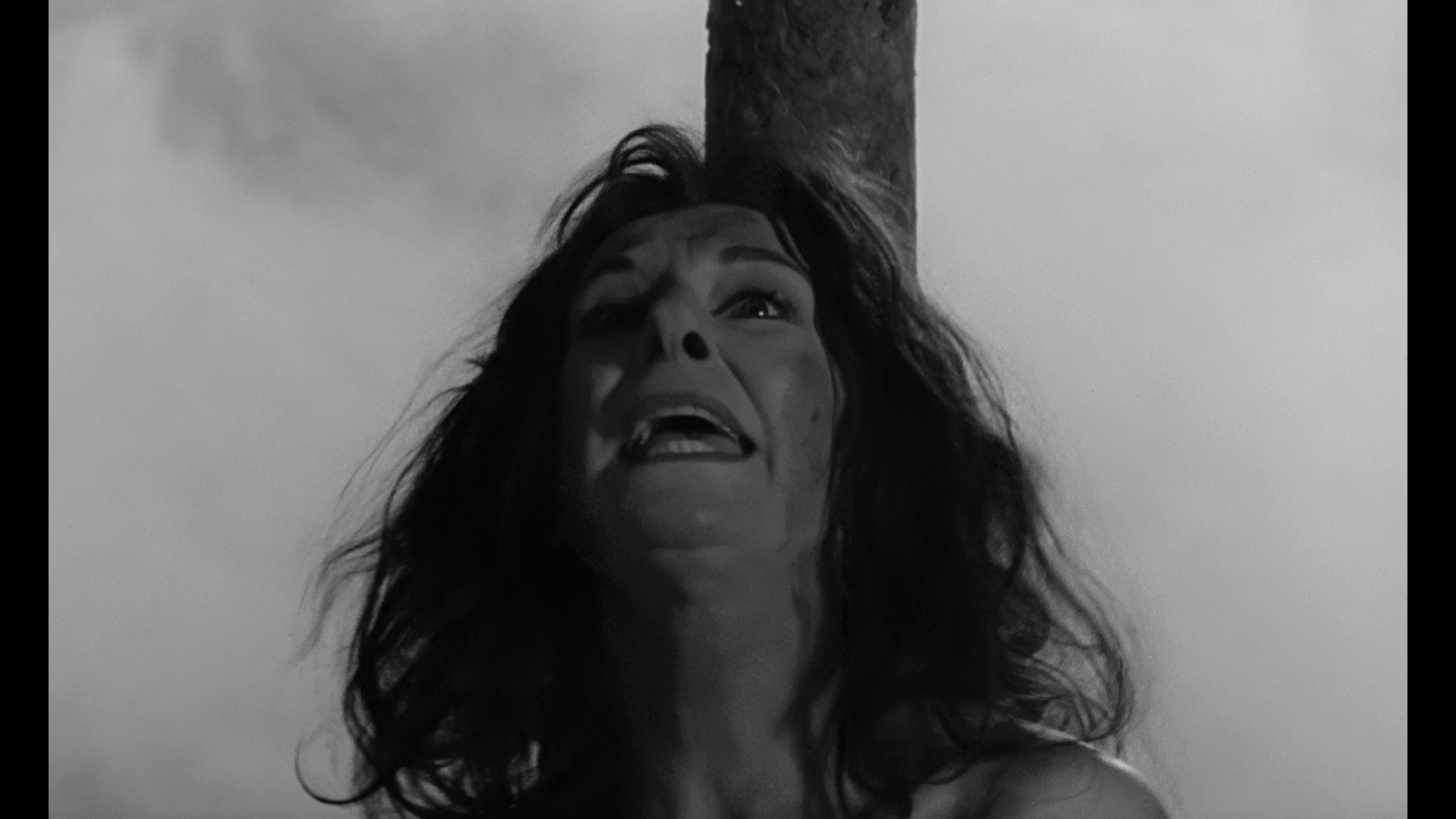 being released during one of the best years ever for cinematic horror, 1960. Two of its contemporary heavyweights, Psycho and Black Sunday (both of which this film resembles in unusual ways), went on to influence a whole decade of U.S. and European filmmaking, while this one quietly crept off and scared the bejeezus out of unsuspecting TV audiences. However, its overwhelming sense of atmosphere and efficiently creepy execution have since helped it rise into the pantheon of great '60s horror films and a tale still capable of chilling more than a few unsuspecting viewers.
being released during one of the best years ever for cinematic horror, 1960. Two of its contemporary heavyweights, Psycho and Black Sunday (both of which this film resembles in unusual ways), went on to influence a whole decade of U.S. and European filmmaking, while this one quietly crept off and scared the bejeezus out of unsuspecting TV audiences. However, its overwhelming sense of atmosphere and efficiently creepy execution have since helped it rise into the pantheon of great '60s horror films and a tale still capable of chilling more than a few unsuspecting viewers. 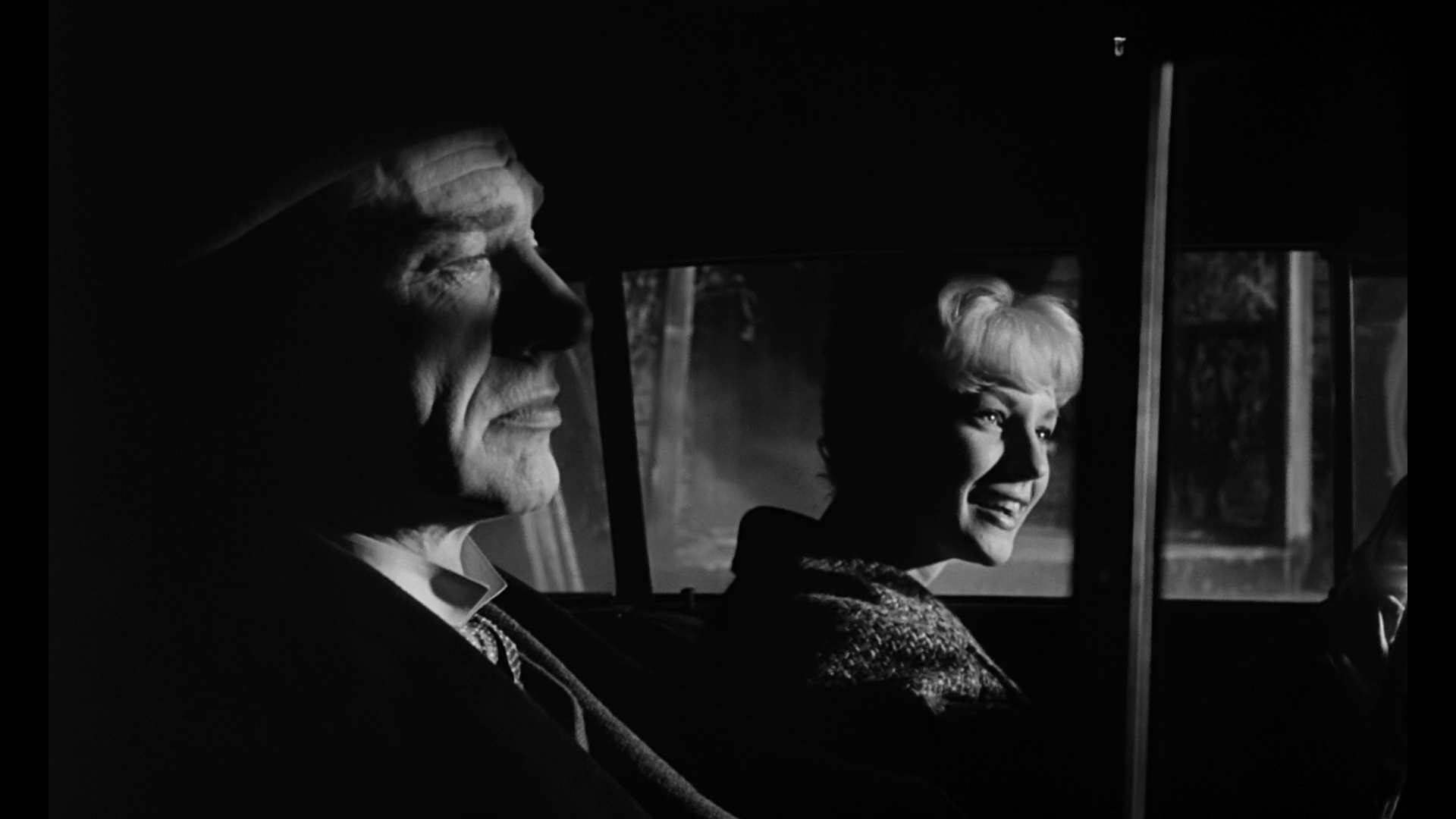 Nan borrows a book from the lovely local librarian (St. John) and settles in for some good, solid fact-finding. When Nan fails to return on time, Bill and Richard fear she might be in trouble and go to Whitewood to find
Nan borrows a book from the lovely local librarian (St. John) and settles in for some good, solid fact-finding. When Nan fails to return on time, Bill and Richard fear she might be in trouble and go to Whitewood to find 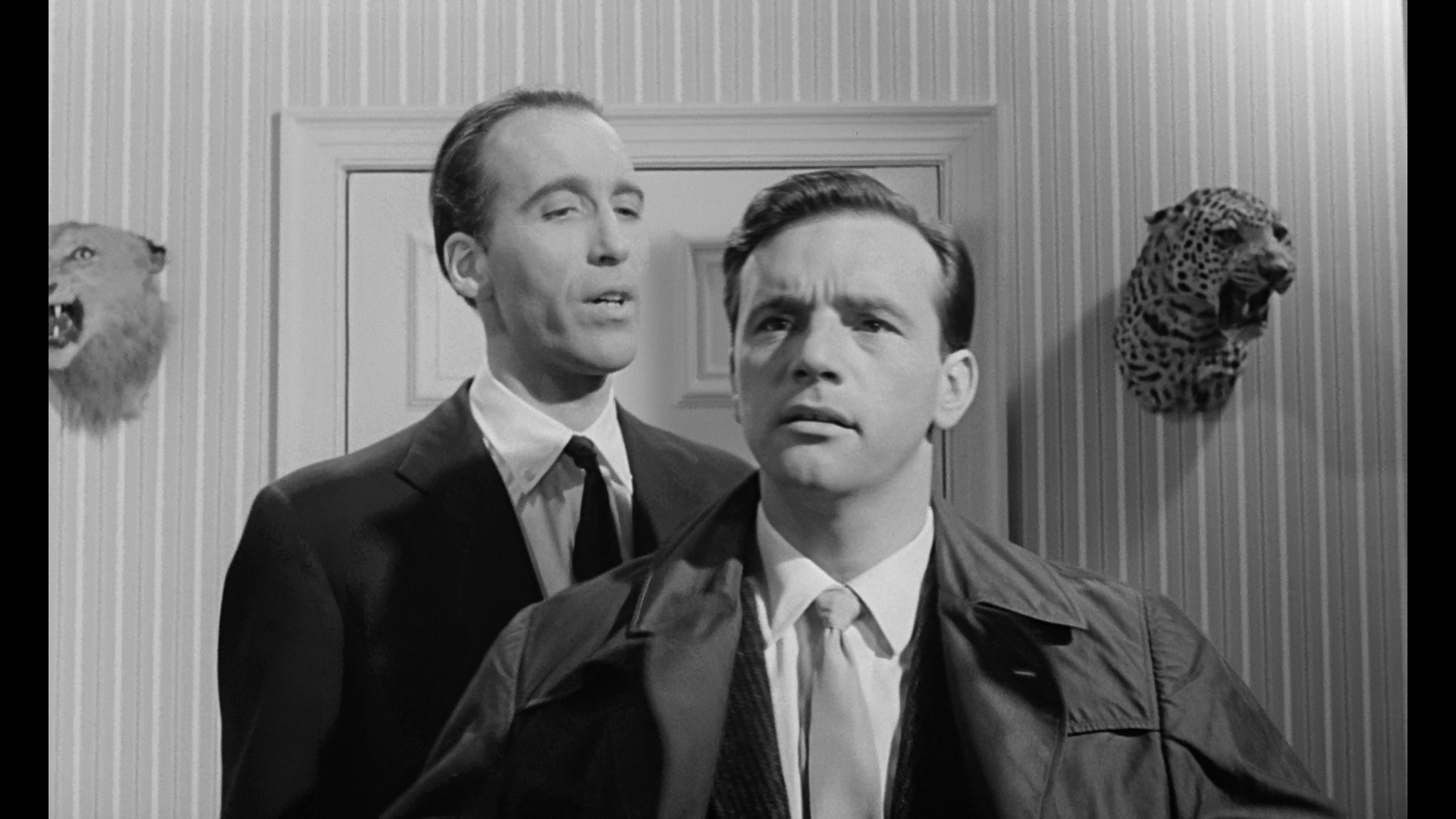 her. What they discover is far more insidious than they could have ever imagined...
her. What they discover is far more insidious than they could have ever imagined...  a relatively
a relatively 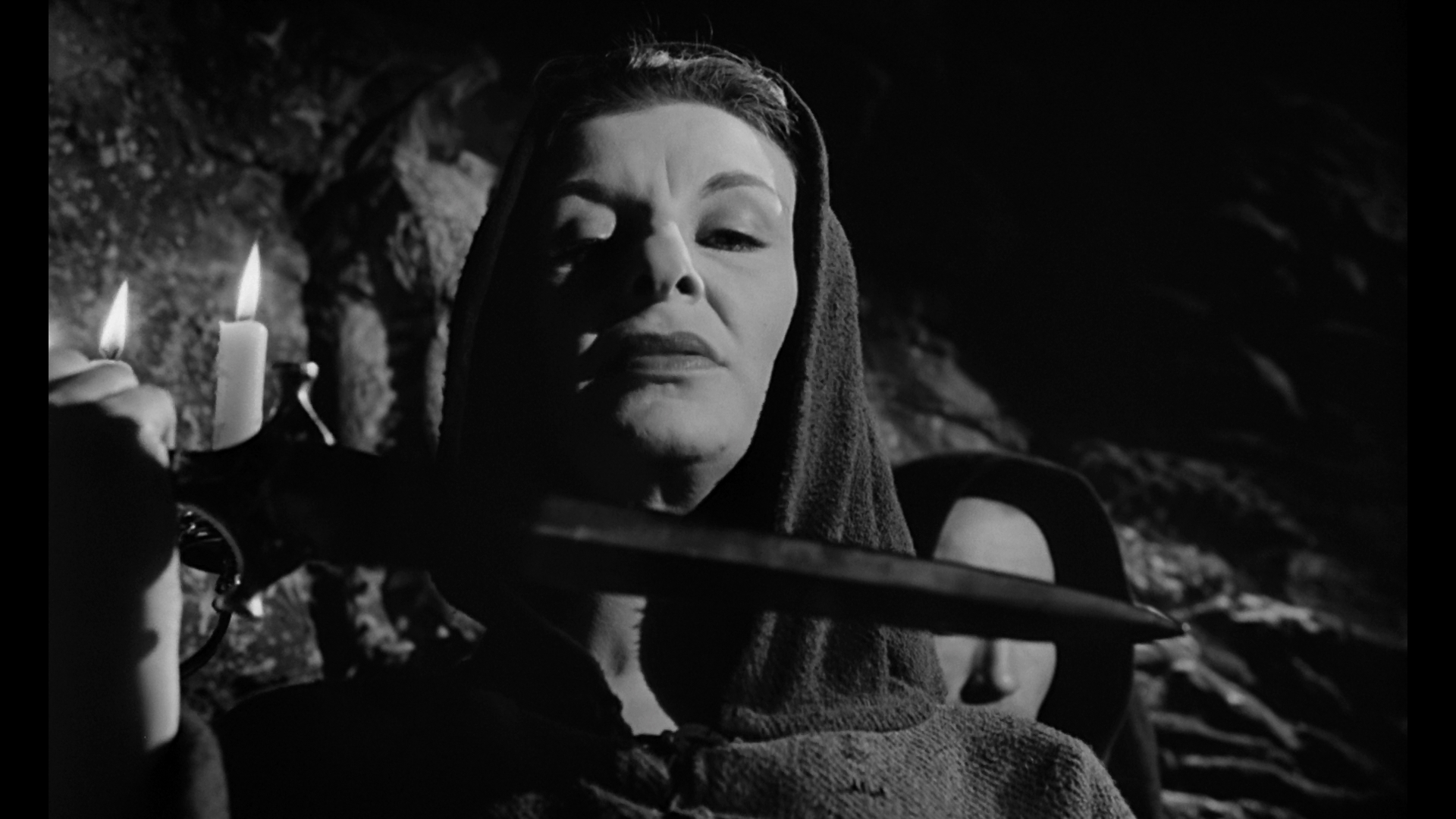 good 16mm print, which suffered only from a five minute stretch of guitar string scratches and, overall, dull black levels. The Roan Group issued another DVD through Troma derived from " the only surviving 35mm elements" but suffered from extensive damage. The Roan edition boasts sharper detail and stronger blacks, but it's also too dark in some scenes (the opening credits are completely impenetrable) and suffers from heavy speckling and scratches at several points. The Elite disc also contains a smudgy looking trailer, while the Roan one omits the trailer in favor of an engaging on-camera discussion by Christopher Lee about the making of the film. The first pressing of the Roan version also includes a very odd and unfortunate Easter Egg involving Lee, but most copies were quickly withdrawn.
good 16mm print, which suffered only from a five minute stretch of guitar string scratches and, overall, dull black levels. The Roan Group issued another DVD through Troma derived from " the only surviving 35mm elements" but suffered from extensive damage. The Roan edition boasts sharper detail and stronger blacks, but it's also too dark in some scenes (the opening credits are completely impenetrable) and suffers from heavy speckling and scratches at several points. The Elite disc also contains a smudgy looking trailer, while the Roan one omits the trailer in favor of an engaging on-camera discussion by Christopher Lee about the making of the film. The first pressing of the Roan version also includes a very odd and unfortunate Easter Egg involving Lee, but most copies were quickly withdrawn. with the American Blu-ray and then some, restoring the correct 1.66:1 framing (adding quite a bit on the top and bottom
with the American Blu-ray and then some, restoring the correct 1.66:1 framing (adding quite a bit on the top and bottom 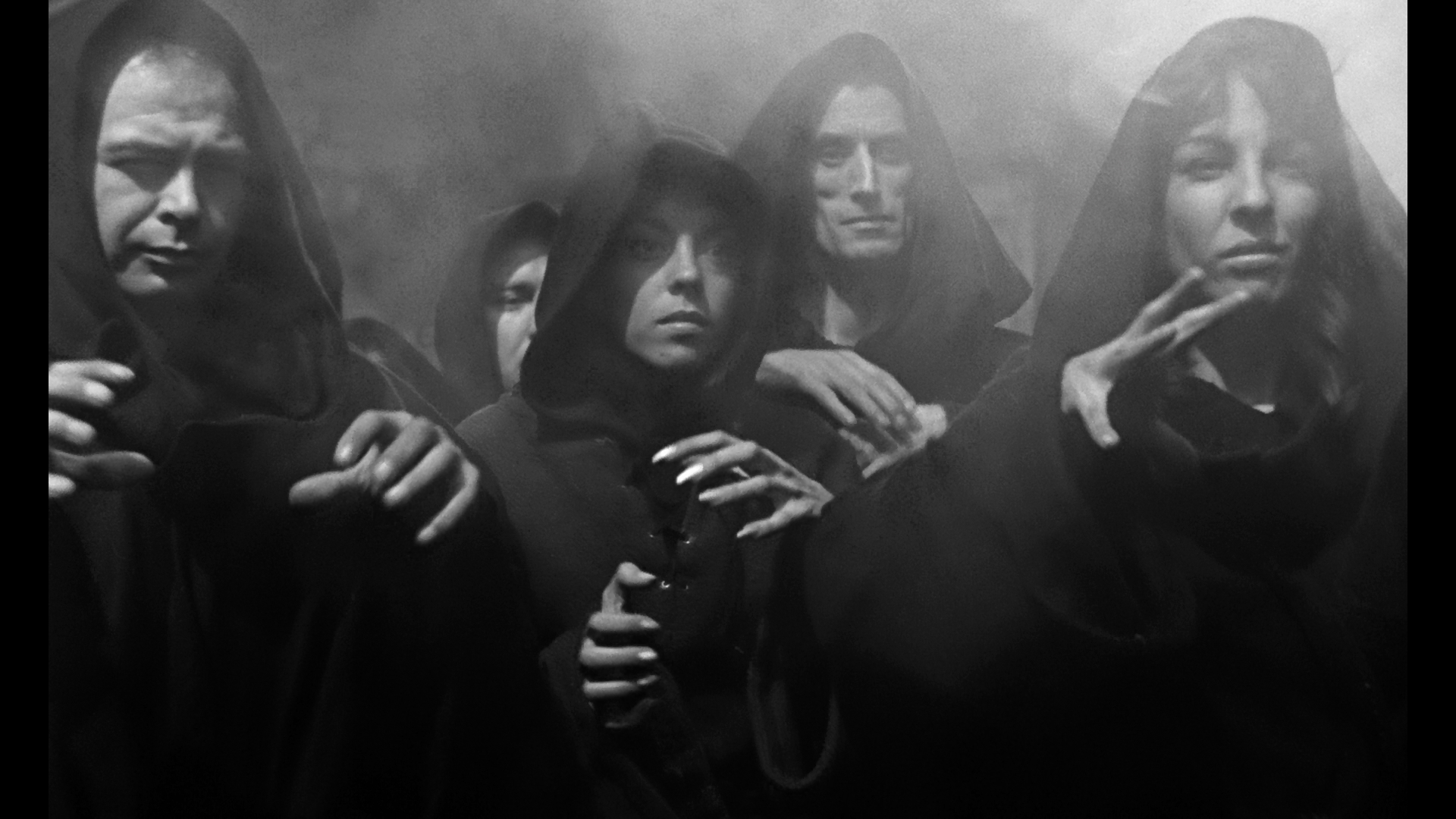 with a sliver less on the left) and giving the film farmore room to breathe on a dual-layered Blu-ray (the better format to watch this film by far). Film grain is fine and modest but appears to be unmanipulated, whites are more pure and strong than the grayish flatness of the prior Blu-ray, and background depth in particular looks much better here for all scenes inside the inn. Frame grabs seen in the body of this review are from the Arrow, while comparison ones from the prior releases are below. The robust LPCM English mono audio (with optional English SDH subtitles) features the best sonic quality of all the releases so far as well, with some nice bass presence at times. The VCI DVD extras have been ported over here -- Moxey and Lee commentaries, the original three featurettes -- with the second Lee piece included as well; basically it's everything except the Hallenbeck commentary, and the U.S. Horror Hotel cut is included as well with identical picture quality. New here is a fine audio commentary by Jonathan Rigby (author of English Gothic: Classic Horror Cinema 1897-2015 and Christopher Lee: The Authorised Screen History), whose sonorous delivery makes for a perfect fit with the film as he weaves together connections to everything from The Curse of Frankenstein and The Skull to Montessori. The packaging features a reversible sleeve with the original poster art and a new design by Graham Humphreys and, in the first pressing only, an insert booklet with new liner notes by the BFI's Vic Pratt and a Moxey text interview.
with a sliver less on the left) and giving the film farmore room to breathe on a dual-layered Blu-ray (the better format to watch this film by far). Film grain is fine and modest but appears to be unmanipulated, whites are more pure and strong than the grayish flatness of the prior Blu-ray, and background depth in particular looks much better here for all scenes inside the inn. Frame grabs seen in the body of this review are from the Arrow, while comparison ones from the prior releases are below. The robust LPCM English mono audio (with optional English SDH subtitles) features the best sonic quality of all the releases so far as well, with some nice bass presence at times. The VCI DVD extras have been ported over here -- Moxey and Lee commentaries, the original three featurettes -- with the second Lee piece included as well; basically it's everything except the Hallenbeck commentary, and the U.S. Horror Hotel cut is included as well with identical picture quality. New here is a fine audio commentary by Jonathan Rigby (author of English Gothic: Classic Horror Cinema 1897-2015 and Christopher Lee: The Authorised Screen History), whose sonorous delivery makes for a perfect fit with the film as he weaves together connections to everything from The Curse of Frankenstein and The Skull to Montessori. The packaging features a reversible sleeve with the original poster art and a new design by Graham Humphreys and, in the first pressing only, an insert booklet with new liner notes by the BFI's Vic Pratt and a Moxey text interview. work like The
work like The  Saint.
Saint. sequence in the big finale. Also covered in the Woodlands doc and presented in its gorgeous 4K
sequence in the big finale. Also covered in the Woodlands doc and presented in its gorgeous 4K  restoration from the negative in 2022 at Cannes as a repertory title, this looks immaculate here on Blu-ray and stands as one of the most impressive Filipino presentations in HD to date. The DTS-HD MA 2.0 mono audio is also nicely restored and features optional English subtitles. A new commentary by Andrew Leavold brings his usual expertise in Filipino cinema into play here explaining why this film was considered groundbreaking at the time and how it interprets the country's strong Christian traditions, as well as tons about De Leon, the cast, and the production overall. The archival "Itim: An Exploration in Cinema" (19m48s) is a 1976 making-of featurette that goes deeper than your average EPK-style piece, including footage from De Leon's now-lost first short film and extensive coverage of the director at work and being interviewed. Finally in "Portrayal of Guilt" (11m1s), Filipino film scholar Anne Frances N. Sangil covers the film's significance and its narrative approach peeling off layers whodunit-style as it heads into dark supernatural territory.
restoration from the negative in 2022 at Cannes as a repertory title, this looks immaculate here on Blu-ray and stands as one of the most impressive Filipino presentations in HD to date. The DTS-HD MA 2.0 mono audio is also nicely restored and features optional English subtitles. A new commentary by Andrew Leavold brings his usual expertise in Filipino cinema into play here explaining why this film was considered groundbreaking at the time and how it interprets the country's strong Christian traditions, as well as tons about De Leon, the cast, and the production overall. The archival "Itim: An Exploration in Cinema" (19m48s) is a 1976 making-of featurette that goes deeper than your average EPK-style piece, including footage from De Leon's now-lost first short film and extensive coverage of the director at work and being interviewed. Finally in "Portrayal of Guilt" (11m1s), Filipino film scholar Anne Frances N. Sangil covers the film's significance and its narrative approach peeling off layers whodunit-style as it heads into dark supernatural territory.![]()